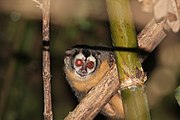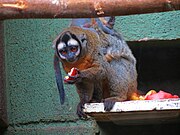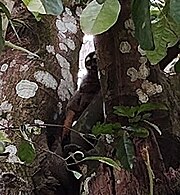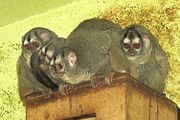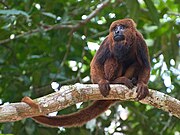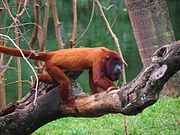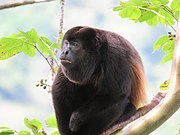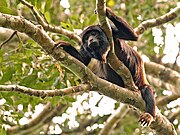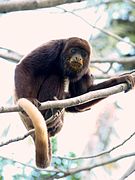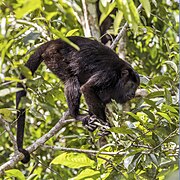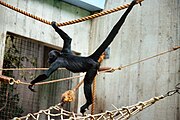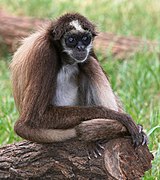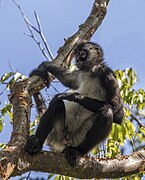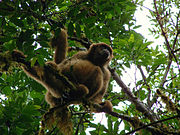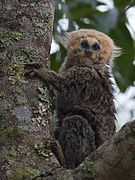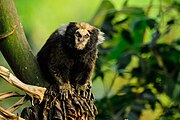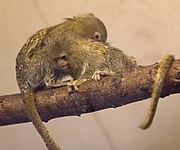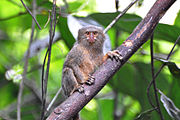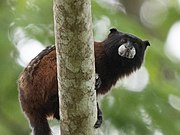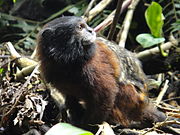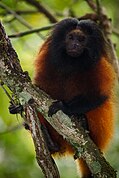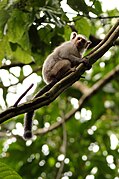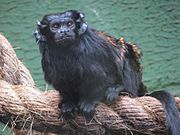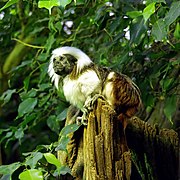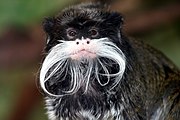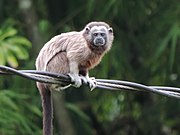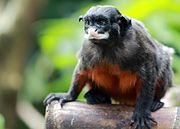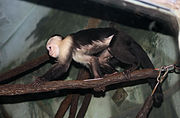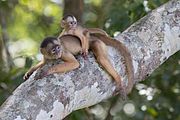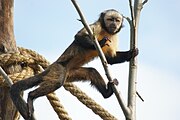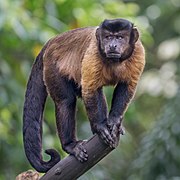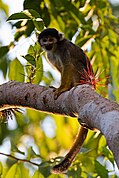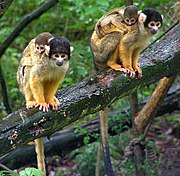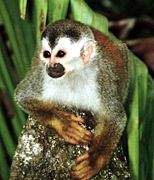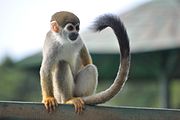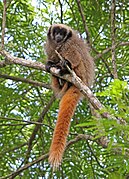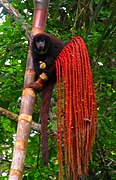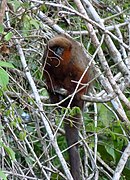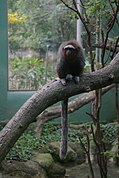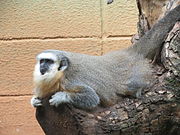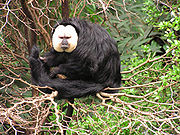List of platyrrhines

Platyrrhini is a parvorder of primates. Members of this parvorder are called platyrrhines, or New World monkeys, and include marmosets, tamarins, and capuchin, squirrel, night, titi, saki, howler, spider, and woolly monkeys. Platyrrhini is one of three clades that form the suborder Haplorrhini, itself one of two suborders in the order Primates. They are found in forests and savannas from South America to Mexico. They range in size from the western pygmy marmoset, at 12 cm (5 in) plus a 17 cm (7 in) tail, to some species of howler monkey in the genus Alouatta, at 92 cm (36 in) plus a 92 cm (36 in) tail. Platyrrhines primarily eat fruit, leaves, and insects. Most platyrrhines do not have population estimates, but the ones that do range from 250 mature individuals to 10,000. Twenty-one species are categorized as endangered, and a further fourteen species are categorized as critically endangered.
The 163 extant species of Platyrrhini are divided into five families. Aotidae contains eleven night monkey species in a single genus. Atelidae contains twenty-three species divided between one genus in the howler monkey subfamily Alouattinae and three genera in the spider monkey and wooly monkey subfamily Atelinae. Callitrichidae contains 53 species of tamarins and marmosets in seven genera. Cebidae contains eighteen species divided between two genera in the capuchin subfamily Cebinae and one genus in the squirrel monkey subfamily Saimiriinae. Pitheciidae contains 57 species divided between three genera in the titi monkey subfamily Callicebinae and three genera in the uakari and saki monkey subfamily Pitheciinae. Dozens of extinct prehistoric platyrrhine species have been discovered, though due to ongoing research and discoveries the exact number and categorization is not fixed.[1]
Conventions
[edit]| Conservation status | |
|---|---|
| EX | Extinct (0 species) |
| EW | Extinct in the wild (0 species) |
| CR | Critically Endangered (14 species) |
| EN | Endangered (21 species) |
| VU | Vulnerable (33 species) |
| NT | Near threatened (14 species) |
| LC | Least concern (74 species) |
| Other categories | |
| DD | Data deficient (7 species) |
| NE | Not evaluated (0 species) |
Conservation status codes listed follow the International Union for Conservation of Nature (IUCN) Red List of Threatened Species. Range maps are provided wherever possible; if a range map is not available, a description of the platyrrhine's range is provided. Ranges are based on the IUCN Red List for that species unless otherwise noted.
Classification
[edit]The parvorder Platyrrhini consists of five extant families: Aotidae, Atelidae, Callitrichidae, Cebidae, and Pitheciidae. Aotidae contains eleven species in one genus. Atelidae is divided into two subfamilies: Alouattinae, containing twelve species in one genus, and Atelinae, containing eleven species in three genera. Callitrichidae contains 53 species in seven genera. Cebidae is divided into two subfamilies: Cebinae, containing eleven species in two genera, and Saimiriinae, containing one genus of seven species. Pitheciidae is divided into two subfamilies: Callicebinae, containing 32 species in three genera, and Pitheciinae, containing 25 species in three genera.
Family Aotidae
- Genus Aotus (night monkeys): eleven species
Family Atelidae
- Subfamily Alouattinae
- Genus Alouatta (howler monkeys): twelve species
- Subfamily Atelinae
- Genus Ateles (spider monkeys): seven species
- Genus Brachyteles (muriquis): two species
- Genus Lagothrix (wooly monkeys): two species
Family Callitrichidae
- Genus Callimico (Goeldi's marmoset): one species
- Genus Callithrix (Atlantic Forest marmosets): six species
- Genus Cebuella (pygmy marmosets): two species
- Genus Leontocebus (saddle-back tamarins): seven species
- Genus Leontopithecus (lion tamarins): four species
- Genus Mico (marmosets): sixteen species
- Genus Saguinus (tamarins): seventeen species
Family Cebidae
- Subfamily Cebinae
- Subfamily Saimiriinae
- Genus Saimiri (squirrel monkeys): seven species
Family Pitheciidae
- Subfamily Callicebinae
- Genus Callicebus (Atlantic Forest titi monkeys): five species
- Genus Cheracebus (widow titi monkeys): five species
- Genus Plecturocebus (Amazonian and Chaco titi monkeys): twenty-two species
- Subfamily Pitheciinae
- Genus Cacajao (uakaris): seven species
- Genus Chiropotes (bearded saki monkeys): five species
- Genus Pithecia (saki monkeys): thirteen species
Platyrrhines
[edit]The following classification is based on the taxonomy described by the reference work Mammal Species of the World (2005), with augmentation by generally accepted proposals made since using molecular phylogenetic analysis, as supported by both the IUCN and the American Society of Mammalogists.[3]
Family Aotidae
[edit]| Common name | Scientific name and subspecies | Range | Size and ecology | IUCN status and estimated population |
|---|---|---|---|---|
| Azara's night monkey | A. azarae (Humboldt, 1811) Three subspecies
|
Central and northeastern South America
|
Size: 24–37 cm (9–15 in) long, plus 31–40 cm (12–16 in) tail[4] Habitat: Forest and savanna[5] Diet: Fruit, as well as nectar, flowers, insects, and other small animals[5] |
LC
|
| Black-headed night monkey | A. nigriceps (Dollman, 1909) |
Central South America
|
Size: 24–37 cm (9–15 in) long, plus 30–39 cm (12–15 in) tail[6] Habitat: Forest[7] Diet: Fruit, insects, fruits, leaves, and flowers[7] |
LC
|
| Brumback's night monkey | A. brumbacki Hershkovitz, 1983 |
Northwestern South America
|
Size: 24–37 cm (9–15 in) long, plus 31–40 cm (12–16 in) tail[8] Habitat: Forest and savanna[9] Diet: Fruit, as well as nectar, flowers, insects, and other small animals[9] |
VU
|
| Gray-bellied night monkey | A. lemurinus I. Geoffroy, 1846 |
Northwestern South America
|
Size: 30–32 cm (12–13 in) long, plus 34–35 cm (13–14 in) tail[10] Habitat: Forest[11] Diet: Fruit, nectar, leaves, and insects, as well as small birds and mammals[12] |
VU
|
| Gray-handed night monkey | A. griseimembra Elliot, 1912 |
Northwestern South America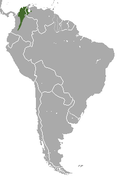
|
Size: 24–37 cm (9–15 in) long, plus 31–40 cm (12–16 in) tail[8] Habitat: Forest[13] Diet: Fruit, as well as nectar, flowers, insects, and other small animals[13] |
VU
|
| Hernández-Camacho's night monkey
|
A. jorgehernandezi Defler & Bueno, 2007 |
Western Colombia
|
Size: 24–37 cm (9–15 in) long, plus 31–40 cm (12–16 in) tail[8] Habitat: Forest[14] Diet: Fruit, as well as nectar, flowers, insects, and other small animals[14] |
DD
|
| Nancy Ma's night monkey | A. nancymaae Hershkovitz, 1983 |
Northwestern South America
|
Size: About 32 cm (13 in) long, plus about 32 cm (13 in) tail[15] Habitat: Forest[16] Diet: Fruit, nectar, and insects[17] |
VU
|
| Panamanian night monkey | A. zonalis Goldman, 1914 |
Northwestern South America and Central America
|
Size: 30–33 cm (12–13 in) long, plus about 30 cm (12 in) tail[18] Habitat: Forest[19] Diet: Fruit, nectar, flowers, insects, and other small animals[19] |
NT
|
| Peruvian night monkey | A. miconax Thomas, 1927 |
Northwestern South America
|
Size: 24–37 cm (9–15 in) long, plus 31–40 cm (12–16 in) tail[8] Habitat: Forest[20] Diet: Fruit, flowers, leaves, buds, and insects[20] |
EN
|
| Spix's night monkey | A. vociferans (Spix, 1823) |
Northwestern South America
|
Size: 24–37 cm (9–15 in) long, plus 32–40 cm (13–16 in) tail[21] Habitat: Forest[22] Diet: Fruit, nectar, flowers, insects, and other small animals[22] |
LC
|
| Three-striped night monkey | A. trivirgatus (Humboldt, 1811) |
Northern South America
|
Size: 24–47 cm (9–19 in) long, plus 22–42 cm (9–17 in) tail[23] Habitat: Forest[24] Diet: Fruit, insects, nectar and leaves, as well as lizards, frogs and eggs[23] |
LC
|
Family Atelidae
[edit]Subfamily Alouattinae
[edit]| Common name | Scientific name and subspecies | Range | Size and ecology | IUCN status and estimated population |
|---|---|---|---|---|
| Amazon black howler
|
A. nigerrima Lönnberg, 1941 |
Central South America
|
Size: 56–91 cm (22–36 in) long, plus 56–91 cm (22–36 in) tail[25] Habitat: Forest and savanna[26] Diet: Leaves, fruit, buds, flowers, seeds, moss, stems, and termite nests[26] |
LC
|
| Black howler | A. caraya (Humboldt, 1812) |
Central South America
|
Size: 51–67 cm (20–26 in) long, plus 51–67 cm (20–26 in) tail[27] Habitat: Forest and savanna[28] Diet: Leaves, as well as fruit, buds and flowers[27] |
NT
|
| Bolivian red howler | A. sara Elliot, 1910 |
Central South America
|
Size: 54–71 cm (21–28 in) long, plus 52–60 cm (20–24 in) tail[29] Habitat: Forest and savanna[30] Diet: Leaves, fruit, buds, flowers, seeds, moss, stems, and termite nests[30] |
NT
|
| Brown howler | A. guariba (Humboldt, 1812) Two subspecies
|
East South America
|
Size: 55–92 cm (22–36 in) long, plus 58–92 cm (23–36 in) tail[31] Habitat: Forest[32] Diet: Leaves, flowers, and fruit[33] |
VU
|
| Colombian red howler | A. seniculus (Linnaeus, 1766) Two subspecies
|
Northwestern South America
|
Size: 48–63 cm (19–25 in) long, plus 52–80 cm (20–31 in) tail[34] Habitat: Forest and savanna[35] Diet: Leaves, fruit, buds, flowers, seeds, moss, stems, and termite nests[36] |
LC
|
| Guyanan red howler | A. macconnelli Linnaeus, 1766 |
Northern South America
|
Size: 55–92 cm (22–36 in) long, plus 58–92 cm (23–36 in) tail[31] Habitat: Forest and savanna[37] Diet: Leaves, fruit, buds, flowers, seeds, moss, stems, and termite nests[37] |
LC
|
| Mantled howler | A. palliata (Gray, 1849) Five subspecies
|
Northwestern South America, Central America, and southern Mexico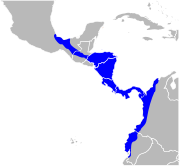
|
Size: 38–58 cm (15–23 in) long, plus 52–67 cm (20–26 in) tail[38] Habitat: Forest[39] Diet: Leaves, fruit, and flowers[38] |
VU
|
| Maranhão red-handed howler
|
A. ululata Elliot, 1912 |
Northeastern Brazil
|
Size: 55–92 cm (22–36 in) long, plus 58–92 cm (23–36 in) tail[31] Habitat: Forest and savanna[40] Diet: Fruit and leaves[40] |
EN
|
| Red-handed howler | A. belzebul (Linnaeus, 1766) |
Northeastern and eastern Brazil
|
Size: 40–65 cm (16–26 in) long, plus 58–10 cm (23–4 in) tail[41] Habitat: Forest[42] Diet: Leaves, bark, and twigs, as well as flowers[41] |
VU
|
| Spix's red-handed howler | A. discolor (Spix, 1823) |
Central Brazil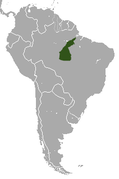
|
Size: 55–92 cm (22–36 in) long, plus 58–92 cm (23–36 in) tail[31] Habitat: Forest[43] Diet: Fruit and leaves, as well as flowers, bark, decaying wood, termite nests, and twigs[43] |
VU
|
| Ursine howler | A. arctoidea A. Cabrera, 1940 |
Northern South America
|
Size: 55–92 cm (22–36 in) long, plus 58–92 cm (23–36 in) tail[31] Habitat: Forest and savanna[44] Diet: Leaves and fruit, as well as buds, flowers, seeds, moss, stems, and termite nests[44] |
LC
|
| Yucatán black howler | A. pigra Lawrence, 1933 |
Yucatán Peninsula in Mexico and Central America
|
Size: 52–71 cm (20–28 in) long, plus 50–69 cm (20–27 in) tail[34] Habitat: Forest[45] Diet: Fruit, leaves, buds, and flowers[46] |
EN
|
Subfamily Atelinae
[edit]| Common name | Scientific name and subspecies | Range | Size and ecology | IUCN status and estimated population |
|---|---|---|---|---|
| Black-headed spider monkey | A. fusciceps Gray, 1866 Two subspecies
|
Northwestern South America (in red)
|
Size: 40–55 cm (16–22 in) long, plus 70–85 cm (28–33 in) tail[47] Habitat: Forest[48] Diet: Fruit, leaves, nuts, seeds, and insects, as well as eggs[47] |
EN
|
| Brown spider monkey | A. hybridus I. Geoffroy, 1829 |
Northwestern South America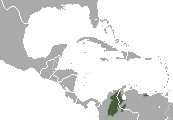
|
Size: 45–50 cm (18–20 in) long, plus 74–81 cm (29–32 in) tail[49] Habitat: Forest[50] Diet: Fruit, as well as leaves, flowers, seeds, bark, honey, decaying wood, termites, and caterpillars[51] |
CR
|
| Geoffroy's spider monkey | A. geoffroyi Kuhl, 1820 Six subspecies
|
Central America and southern Mexico (in blue)
|
Size: 30–63 cm (12–25 in) long, plus 63–84 cm (25–33 in) tail[52] Habitat: Forest[53] Diet: Fruit, leaves, and flowers, as well as nuts, seeds, insects, arachnids, and eggs[52] |
EN
|
| Peruvian spider monkey | A. chamek (Humboldt, 1812) |
Central South America
|
Size: 40–60 cm (16–24 in) long, plus 70–88 cm (28–35 in) tail[49] Habitat: Forest[54] Diet: Fruit, as well as flowers, insects, and leaves[55] |
EN
|
| Red-faced spider monkey | A. paniscus (Linnaeus, 1758) |
Northern South America
|
Size: 38–63 cm (15–25 in) long, plus 50–89 cm (20–35 in) tail[56] Habitat: Forest[57] Diet: Fruit, as well as leaves, flowers, seeds, roots, and fungi[58] |
VU
|
| White-bellied spider monkey | A. belzebuth Geoffroy, 1806 |
Northwestern South America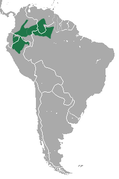
|
Size: 34–59 cm (13–23 in) long, plus 61–88 cm (24–35 in) tail[59] Habitat: Forest[60] Diet: Fruit, as well as leaves, flowers, seeds, roots, decaying wood, honey, and insects[60] |
EN
|
| White-cheeked spider monkey | A. marginatus Geoffroy, 1809 |
North-central South America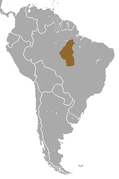
|
Size: 38–63 cm (15–25 in) long, plus 50–89 cm (20–35 in) tail[56] Habitat: Forest[61] Diet: Fruit, as well as leaves, flowers, seeds, roots, decaying wood, honey, and insects[61] |
EN
|
| Common name | Scientific name and subspecies | Range | Size and ecology | IUCN status and estimated population |
|---|---|---|---|---|
| Northern muriqui | B. hypoxanthus (Kuhl, 1820) |
Southeastern Brazil
|
Size: 46–50 cm (18–20 in) long, plus 72–81 cm (28–32 in) tail[62] Habitat: Forest[63] Diet: Leaves, fruit, vines, flowers, bark, nectar, and seeds[62] |
CR
|
| Southern muriqui | B. arachnoides (Geoffroy, 1806) |
Southeastern Brazil
|
Size: 46–50 cm (18–20 in) long, plus 72–81 cm (28–32 in) tail[62] Habitat: Forest[64] Diet: Fruit, leaves, flowers, and seeds[65] |
CR
|
| Common name | Scientific name and subspecies | Range | Size and ecology | IUCN status and estimated population |
|---|---|---|---|---|
| Common woolly monkey | L. lagotricha (Humboldt, 1812) Five subspecies
|
Northwestern South America
|
Size: 55–69 cm (22–27 in) long, plus 60–72 cm (24–28 in) tail[66] Habitat: Forest, savanna[67] Diet: Fruit, as well as leaves, seeds, and insects[66] |
VU
|
| Yellow-tailed woolly monkey | L. flavicauda Humboldt, 1812 |
Western South America | Size: 44–53 cm (17–21 in) long, plus 60–65 cm (24–26 in) tail[68] Habitat: Forest[69] Diet: Fruit, leaves, insects, moss, buds, and flowers[69] |
CR
|
Family Callitrichidae
[edit]| Common name | Scientific name and subspecies | Range | Size and ecology | IUCN status and estimated population |
|---|---|---|---|---|
| Goeldi's marmoset | C. goeldii Thomas, 1904 |
Western South America
|
Size: 21–23 cm (8–9 in) long, plus 25–33 cm (10–13 in) tail[70] Habitat: Forest[71] Diet: Fruit, insects, and fungi, as well as lizards, frogs, and other small vertebrates[70] |
VU
|
| Common name | Scientific name and subspecies | Range | Size and ecology | IUCN status and estimated population |
|---|---|---|---|---|
| Black-tufted marmoset | C. penicillata (Geoffroy, 1812) |
Eastern South America
|
Size: 22–28 cm (9–11 in) long, plus 44–56 cm (17–22 in) tail[72] Habitat: Forest and savanna[73] Diet: Tree sap, as well as fruit, insects, arthropods, molluscs, and small vertebrates[74] |
LC
|
| Buffy-headed marmoset | C. flaviceps (Thomas, 1903) |
Eastern South America
|
Size: 18–30 cm (7–12 in) long, plus 17–41 cm (7–16 in) tail[75] Habitat: Forest[76] Diet: Plant gum, as well as fruit, seeds, nectar, and flowers[75] |
CR
|
| Buffy-tufted marmoset | C. aurita (Geoffroy, 1812) |
Eastern South America
|
Size: 18–30 cm (7–12 in) long, plus 17–41 cm (7–16 in) tail[77] Habitat: Forest[78] Diet: Ants, termites, larvae, caterpillars, and large-winged insects[79] |
EN
|
| Common marmoset | C. jacchus (Linnaeus, 1758) |
Eastern South America
|
Size: 12–15 cm (5–6 in) long, plus 29–35 cm (11–14 in) tail[80] Habitat: Forest and savanna[81] Diet: Tree sap, insects, spiders, fruit, flowers, and nectar, as well as small lizards, bird's eggs, nestlings, and frogs[80] |
LC
|
| White-headed marmoset | C. geoffroyi (Humboldt, 1812) |
Eastern South America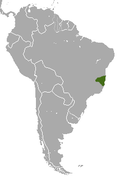
|
Size: 18–23 cm (7–9 in) long, plus about 29 cm (11 in) tail[82] Habitat: Forest and savanna[83] Diet: Fruit, insects, and plant gums, as well as flowers, nectar, frogs, snails, lizards, and spiders[84] |
LC
|
| Wied's marmoset | C. kuhlii Coimbra-Filho, 1985 |
Eastern South America
|
Size: 20–22 cm (8–9 in) long, plus 27–31 cm (11–12 in) tail[85] Habitat: Forest[86] Diet: Sap, fruit, flowers, nectar, seeds, insects, and spiders[87] |
VU
|
| Common name | Scientific name and subspecies | Range | Size and ecology | IUCN status and estimated population |
|---|---|---|---|---|
| Eastern pygmy marmoset | C. niveiventris Lönnberg, 1940 |
Western South America | Size: 18–30 cm (7–12 in) long, plus 17–41 cm (7–16 in) tail[77] Habitat: Forest[88] Diet: Tree gum[88] |
VU
|
| Western pygmy marmoset | C. pygmaea (Spix, 1823) |
Western South America | Size: 12–15 cm (5–6 in) long, plus 17–23 cm (7–9 in) tail[82] Habitat: Forest[89] Diet: Tree gum, sap, and resin, as well as insects, small lizards, fruit, flowers, and spiders[90] |
VU
|
| Common name | Scientific name and subspecies | Range | Size and ecology | IUCN status and estimated population |
|---|---|---|---|---|
| Andean saddle-back tamarin | L. leucogenys (Gray, 1866) |
Western South America
|
Size: 17–31 cm (7–12 in) long, plus 25–44 cm (10–17 in) tail[91] Habitat: Forest[92] Diet: Fruit pulp, sap, nectar, invertebrates, and small vertebrates[92] |
LC
|
| Cruz Lima's saddle-back tamarin | L. cruzlimai (Hershkovitz, 1966) |
Central South America
|
Size: 17–31 cm (7–12 in) long, plus 25–44 cm (10–17 in) tail[91] Habitat: Forest[93] Diet: Fruit, sap, nectar, vegetation, spiders, small vertebrates, and eggs[91] |
LC
|
| Geoffroy's saddle-back tamarin | L. nigrifrons (I. Geoffroy, 1850) |
Western South America
|
Size: 17–31 cm (7–12 in) long, plus 25–44 cm (10–17 in) tail[91] Habitat: Forest[94] Diet: Fruit pulp, sap, nectar, invertebrates and small vertebrates[94] |
LC
|
| Illiger's saddle-back tamarin | L. illigeri (Pucheran, 1845) |
Western South America
|
Size: 17–31 cm (7–12 in) long, plus 25–44 cm (10–17 in) tail[91] Habitat: Forest[95] Diet: Fruit pulps, sap, nectar, invertebrates, and small vertebrates[95] |
NT
|
| Lesson's saddle-back tamarin | L. fuscus (Lesson, 1840) |
Western South America
|
Size: 17–31 cm (7–12 in) long, plus 25–44 cm (10–17 in) tail[91] Habitat: Forest[96] Diet: Fruit, nectar, gum, and small animals[96] |
LC
|
| Red-mantled saddle-back tamarin | L. lagonotus (Espada, 1870) |
Western South America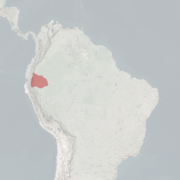
|
Size: 17–31 cm (7–12 in) long, plus 25–44 cm (10–17 in) tail[91] Habitat: Forest[97] Diet: Fruit pulp, sap, nectar, invertebrates, and small vertebrates[97] |
LC
|
| Weddell's saddle-back tamarin | L. weddelli (Deville, 1849) Three subspecies
|
Western South America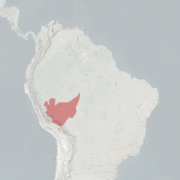
|
Size: About 19 cm (7 in) long, plus about 30 cm (12 in) tail[98] Habitat: Forest[99] Diet: Fruit pulp, sap, nectar, invertebrates, and small vertebrates[99] |
LC
|
| Common name | Scientific name and subspecies | Range | Size and ecology | IUCN status and estimated population |
|---|---|---|---|---|
| Black lion tamarin | L. chrysopygus (Mikan, 1823) |
Southeastern South America
|
Size: 20–34 cm (8–13 in) long, plus 31–40 cm (12–16 in) tail[100] Habitat: Forest[101] Diet: Insects and fruit, as well as lizards, birds, other small vertebrates, and bird eggs[100] |
EN
|
| Golden lion tamarin | L. rosalia (Linnaeus, 1766) |
Southeastern South America
|
Size: 20–37 cm (8–15 in) long, plus 31–40 cm (12–16 in) tail[102] Habitat: Forest[103] Diet: Spiders, snails, small lizards, eggs, small birds, fruit, and vegetables[102] |
EN
|
| Golden-headed lion tamarin | L. chrysomelas (Kuhl, 1820) |
Eastern South America
|
Size: 20–34 cm (8–13 in) long, plus 31–40 cm (12–16 in) tail[104] Habitat: Forest[105] Diet: Insects and fruit, as well as lizards, birds, other small vertebrates, and bird eggs[104] |
EN
|
| Superagüi lion tamarin | L. caissara Lorini & Guerra, 1990 |
Southeastern South America
|
Size: About 30 cm (12 in) long, plus about 43 cm (17 in) tail[106] Habitat: Forest[107] Diet: Fruit, flowers, gum, and nectar, as well as insects, small lizards, and snakes[108] |
EN
|
| Common name | Scientific name and subspecies | Range | Size and ecology | IUCN status and estimated population |
|---|---|---|---|---|
| Black-headed marmoset
|
M. nigriceps Ferrari & Lopes, 1992 |
Central South America
|
Size: 18–30 cm (7–12 in) long, plus 17–41 cm (7–16 in) tail[77] Habitat: Forest[109] Diet: Fruit, flowers, nectar, gum, sap, frogs, snails, lizards, spiders, and insects[109] |
NT
|
| Black-tailed marmoset | M. melanurus (Geoffroy, 1812) |
Central South America
|
Size: 18–30 cm (7–12 in) long, plus 17–41 cm (7–16 in) tail[77] Habitat: Savanna and shrubland[110] Diet: Insects, spiders, small vertebrates, eggs, fruit, and sap[77] |
NT
|
| Emilia's marmoset | M. emiliae (Thomas, 1920) |
Central South America
|
Size: About 22 cm (9 in) long, plus about 34 cm (13 in) tail[111] Habitat: Forest and savanna[112] Diet: Fruit, flowers, nectar, gum, sap, frogs, snails, lizards, spiders, and insects[112] |
LC
|
| Gold-and-white marmoset | M. chrysoleucos (Wagner, 1842) |
Central South America
|
Size: 19–26 cm (7–10 in) long, plus 30–36 cm (12–14 in) tail[113] Habitat: Forest[114] Diet: Gum and sap, as well as seeds, fruit, nuts, insects, and small vertebrates[113] |
LC
|
| Hershkovitz's marmoset | M. intermedius Hershkovitz, 1977 |
Central South America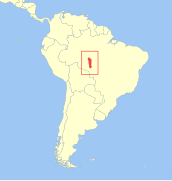
|
Size: 18–30 cm (7–12 in) long, plus 17–41 cm (7–16 in) tail[77] Habitat: Forest[115] Diet: Fruit, flowers, nectar, gum, sap, frogs, snails, lizards, spiders, and insects[115] |
LC
|
| Marca's marmoset
|
M. marcai Alperin, 1993 |
Central South America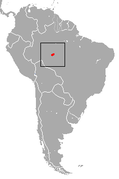
|
Size: 18–30 cm (7–12 in) long, plus 17–41 cm (7–16 in) tail[77] Habitat: Forest[116] Diet: Fruit, flowers, nectar, gum, sap, frogs, snails, lizards, spiders, and insects[116] |
VU
|
| Maués marmoset
|
M. mauesi R. A. Mittermeier, Schwarz & Ayres, 1992 |
Central South America
|
Size: 19–23 cm (7–9 in) long, plus 34–38 cm (13–15 in) tail[117] Habitat: Forest[117] Diet: Fruit, flowers, nectar, gum, sap, frogs, snails, lizards, spiders, and insects[117] |
LC
|
| Munduruku marmoset | M. munduruku Costa-Araújo, Farias, Hrbek, 2019 |
Central South America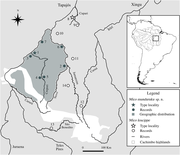
|
Size: 18–30 cm (7–12 in) long, plus 17–41 cm (7–16 in) tail[77] Habitat: Forest[118] Diet: Insects, spiders, small vertebrates, eggs, fruit, and sap[77] |
VU
|
| Rio Acarí marmoset
|
M. acariensis (M. van Roosmalen, T. van Roosmalen, R. A. Mittermeier, & Rylands, 2000) |
Central South America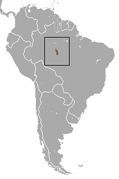
|
Size: 18–30 cm (7–12 in) long, plus 17–41 cm (7–16 in) tail[77] Habitat: Forest[119] Diet: Fruit, flowers, nectar, gum, sap, frogs, snails, lizards, spiders, and insects[119] |
LC
|
| Rondon's marmoset | M. rondoni Ferrari, Sena, Schneider, & Silva Jr., 2010 |
Central South America
|
Size: 18–30 cm (7–12 in) long, plus 17–41 cm (7–16 in) tail[77] Habitat: Forest[120] Diet: Fruit, flowers, nectar, gum, sap, frogs, snails, lizards, spiders, and insects[120] |
VU
|
| Roosmalens' dwarf marmoset
|
M. humilis (M. Roosmalen, 1998) |
Central South America
|
Size: 18–30 cm (7–12 in) long, plus 17–41 cm (7–16 in) tail[77] Habitat: Forest[121] Diet: Insects, fruit and gum[121] |
LC
|
| Santarem marmoset | M. humeralifer (Geoffroy, 1812) |
Central South America
|
Size: 18–30 cm (7–12 in) long, plus 17–41 cm (7–16 in) tail[77] Habitat: Forest[122] Diet: Fruit, flowers, nectar, gum, sap, frogs, snails, lizards, spiders, and insects[122] |
NT
|
| Satéré marmoset
|
M. saterei Noronha & Silva Jr., 1998 |
Central South America
|
Size: 19–23 cm (7–9 in) long, plus 34–36 cm (13–14 in) tail[123] Habitat: Forest[123] Diet: Insects, spiders, small vertebrates, eggs, fruit, and sap[77] |
LC
|
| Schneider's marmoset | M. schneideri Costa-Araújo et al., 2021 |
Central South America (in dark gray)
|
Size: 18–30 cm (7–12 in) long, plus 17–41 cm (7–16 in) tail[77] Habitat: Forest[124] Diet: Insects, spiders, small vertebrates, eggs, fruit, and sap[77] |
EN
|
| Silvery marmoset | M. argentatus (Linnaeus, 1766) |
Central South America
|
Size: 20–23 cm (8–9 in) long, plus 26–33 cm (10–13 in) tail[82] Habitat: Forest and savanna[125] Diet: Sap and gum, as well as fruit, insects, and leaves[126] |
LC
|
| White marmoset | M. leucippe (Thomas, 1922) |
Central South America
|
Size: 20–24 cm (8–9 in) long, plus 26–37 cm (10–15 in) tail[127] Habitat: Forest[127] Diet: Fruit, flowers, nectar, gum, sap, frogs, snails, lizards, spiders, and insects[127] |
LC
|
| Common name | Scientific name and subspecies | Range | Size and ecology | IUCN status and estimated population |
|---|---|---|---|---|
| Brown-mantled tamarin | S. fuscicollis Spix, 1823 Four subspecies
|
West-central South America
|
Size: 21–23 cm (8–9 in) long, plus about 43 cm (17 in) tail[128] Habitat: Forest[129] Diet: Fruit, flowers, nectar, gum, sap, frogs, snails, lizards, spiders, and insects[129] |
LC
|
| Black-mantled tamarin | S. nigricollis Spix, 1823 Three subspecies
|
West-central South America
|
Size: 22–23 cm (9 in) long, plus 35–37 cm (14–15 in) tail[130] Habitat: Forest[131] Diet: Insects, fruit, seeds, flowers, nectar, and gum[130] |
LC
|
| Black tamarin | S. niger (Geoffroy, 1803) |
Eastern South America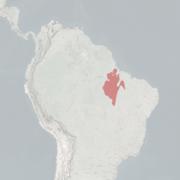
|
Size: 17–31 cm (7–12 in) long, plus 25–44 cm (10–17 in) tail[91] Habitat: Forest[132] Diet: Fruit, flowers, nectar, gum, sap, frogs, snails, lizards, spiders, and insects[132] |
VU
|
| Cotton-top tamarin | S. oedipus (Linnaeus, 1758) |
Northwestern South America
|
Size: 20–25 cm (8–10 in) long, plus 33–40 cm (13–16 in) tail[82] Habitat: Forest[133] Diet: Insects, fruit, and gum[134] |
CR
|
| Eastern black-handed tamarin
|
S. ursula Hoffmannsegg, 1807 |
Eastern South America
|
Size: 17–31 cm (7–12 in) long, plus 25–44 cm (10–17 in) tail[91] Habitat: Forest[135] Diet: Fruit, flowers, nectar, gum, sap, frogs, snails, lizards, spiders, and insects[135] |
VU
|
| Emperor tamarin | S. imperator (Goeldi, 1907) Two subspecies
|
Western South America
|
Size: 23–27 cm (9–11 in) long, plus 35–43 cm (14–17 in) tail[136] Habitat: Forest[137] Diet: Fruit, insects, and tree sap, as well as lizards, tree frogs, and bird eggs[136] |
LC
|
| Geoffroy's tamarin | S. geoffroyi (Pucheran, 1845) |
Northwestern South America and southeastern Central America
|
Size: 20–29 cm (8–11 in) long, plus 31–42 cm (12–17 in) tail[138] Habitat: Forest[139] Diet: Fruit, flowers, nectar, gum, sap, frogs, snails, lizards, spiders, and insects[139] |
NT
|
| Golden-handed tamarin | S. midas (Linnaeus, 1758) |
Northeastern South America
|
Size: 20–28 cm (8–11 in) long, plus 31–44 cm (12–17 in) tail[140] Habitat: Forest and savanna[141] Diet: Fruit, flowers, nectar, gum, sap, frogs, snails, lizards, spiders, and insects[141] |
LC
|
| Golden-mantled tamarin | S. tripartitus H. Milne-Edwards, 1878 |
Western South America
|
Size: 21–24 cm (8–9 in) long, plus 31–35 cm (12–14 in) tail[142] Habitat: Forest[143] Diet: Fruit, flowers, nectar, gum, sap, frogs, snails, lizards, spiders, and insects[143] |
NT
|
| Martins's tamarin
|
S. martinsi (Thomas, 1912) Two subspecies
|
Central South America
|
Size: 17–31 cm (7–12 in) long, plus 25–44 cm (10–17 in) tail[91] Habitat: Forest[144] Diet: Fruit, flowers, nectar, gum, sap, frogs, snails, lizards, spiders, and insects[144] |
NT
|
| Mottle-faced tamarin | S. inustus (Schwartz, 1951) |
West-central South America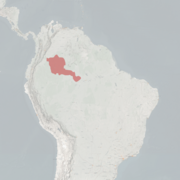
|
Size: 17–31 cm (7–12 in) long, plus 25–44 cm (10–17 in) tail[91] Habitat: Forest[145] Diet: Fruit, insects, and spiders[145] |
LC
|
| Moustached tamarin | S. mystax (Spix, 1823) Two subspecies
|
West-central South America
|
Size: 24–25 cm (9–10 in) long, plus about 38 cm (15 in) tail[146] Habitat: Forest[147] Diet: Fruit, flowers, nectar, insects, sap, gum, and soil[148] |
LC
|
| Pied tamarin | S. bicolor Spix, 1823 |
Central South America
|
Size: 20–29 cm (8–11 in) long, plus 33–42 cm (13–17 in) tail[149] Habitat: Forest[150] Diet: Fruit, flowers, and sap, as well as gum and insects[149] |
CR
|
| Red-capped tamarin | S. pileatus I. Geoffroy & Deville, 1848 |
Central South America | Size: 17–31 cm (7–12 in) long, plus 25–44 cm (10–17 in) tail[91] Habitat: Forest[151] Diet: Fruit pulp, sap, nectar, invertebrates, and small vertebrates[151] |
LC
|
| White-footed tamarin | S. leucopus (Günther, 1877) |
Northwestern South America
|
Size: 17–31 cm (7–12 in) long, plus 25–44 cm (10–17 in) tail[91] Habitat: Forest[152] Diet: Fruit, flowers, nectar, gum, sap, frogs, snails, lizards, spiders, and insects[152] |
VU
|
| White-lipped tamarin | S. labiatus (Humboldt, 1812) Three subspecies
|
Central South America
|
Size: 17–31 cm (7–12 in) long, plus 25–44 cm (10–17 in) tail[91] Habitat: Forest[153] Diet: Fruit, nectar, insects, and sap[154] |
LC
|
| White-mantled tamarin | S. melanoleucus Miranda-Ribeiro, 1912 |
West-central South America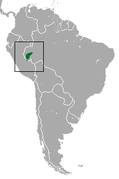
|
Size: 17–31 cm (7–12 in) long, plus 25–44 cm (10–17 in) tail[91] Habitat: Forest[155] Diet: Fruit, flowers, nectar, gum, sap, frogs, snails, lizards, spiders, and insects[155] |
LC
|
Family Cebidae
[edit]Subfamily Cebinae
[edit]| Common name | Scientific name and subspecies | Range | Size and ecology | IUCN status and estimated population |
|---|---|---|---|---|
| Colombian white-faced capuchin | C. capucinus (Linnaeus, 1758) Three subspecies
|
Northwestern South America and southeastern Central America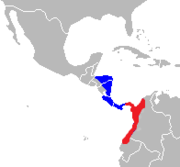
|
Size: 33–46 cm (13–18 in) long, plus about 55 cm (22 in) tail[156] Habitat: Forest and savanna[157] Diet: Fruit and nuts, as well as insects, other invertebrates, and small vertebrates including squirrels, tree rats, lizards, and birds[158] |
VU
|
| Kaapori capuchin | C. kaapori Queiroz, 1992 |
Northeastern South America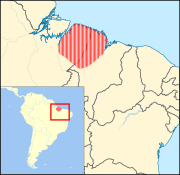
|
Size: 30–57 cm (12–22 in) long, plus 30–56 cm (12–22 in) tail[159] Habitat: Forest[160] Diet: Fruit, insects, and seeds[160] |
CR
|
| Wedge-capped capuchin | C. olivaceus Schomburgk, 1848 |
Northern South America
|
Size: 37–46 cm (15–18 in) long, plus 40–55 cm (16–22 in) tail[161] Habitat: Forest[162] Diet: Fruit, palm nuts, seeds, berries, small vertebrates, and invertebrates[163] |
LC
|
| Humboldt's white-fronted capuchin | C. albifrons Humboldt, 1812 Six subspecies
|
Central South America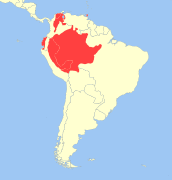
|
Size: About 37 cm (15 in) long, plus about 42 cm (17 in) tail[164] Habitat: Forest and savanna[165] Diet: Fruit, as well as insects, other small invertebrates, palm nuts, figs, and nectar[166] |
LC
|
| Common name | Scientific name and subspecies | Range | Size and ecology | IUCN status and estimated population |
|---|---|---|---|---|
| Black capuchin | S. nigritus Goldfuss, 1809 Two subspecies
|
Southeastern South America
|
Size: 32–55 cm (13–22 in) long, plus 35–50 cm (14–20 in) tail[167] Habitat: Forest[168] Diet: Fruit, berries, seeds, leaves, and nuts, as well as young frogs, birds, insects, and eggs[167] |
NT
|
| Azaras's capuchin | S. cay (Illiger, 1815) |
Central South America
|
Size: 30–57 cm (12–22 in) long, plus 30–56 cm (12–22 in) tail[159] Habitat: Forest and savanna[169] Diet: Fruit, seeds, arthropods, frogs, birds, primates, and small mammals, as well as stems and flower buds[169] |
VU
|
| Black-striped capuchin | S. libidinosus Spix, 1823 |
Eastern South America
|
Size: 30–57 cm (12–22 in) long, plus 30–56 cm (12–22 in) tail[159] Habitat: Forest and savanna[170] Diet: Fruit, seeds, arthropods, frogs, birds, and small mammals, as well as stems, flowers and leaves[170] |
NT
|
| Blond capuchin | S. flavius Schreber, 1774 |
Eastern South America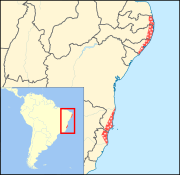
|
Size: 33–40 cm (13–16 in) long, plus 36–50 cm (14–20 in) tail[171] Habitat: Forest[171] Diet: Fruit, insects, palm nuts, and sugar cane[171] |
EN
|
| Crested capuchin | S. robustus Kuhl, 1820 |
Eastern South America
|
Size: 30–57 cm (12–22 in) long, plus 30–56 cm (12–22 in) tail[159] Habitat: Forest[172] Diet: Fruit, seeds, arthropods, frogs, birds, and small mammals, as well as stems, flowers and leaves[172] |
EN
|
| Golden-bellied capuchin | S. xanthosternos Wied-Neuwied, 1826 |
Eastern South America
|
Size: 35–49 cm (14–19 in) long, plus 37–49 cm (15–19 in) tail[173] Habitat: Forest, savanna, and shrubland[174] Diet: Fruit, seeds, nectar, pith, stems, nuts, berries, flowers, leaves, bird eggs, insects, frogs, small reptiles, birds, bats, other small mammals, oysters, and crabs[173] |
CR
|
| Tufted capuchin | S. apella (Linnaeus, 1758) Two subspecies
|
Northern South America
|
Size: 38–46 cm (15–18 in) long, plus 38–39 cm (15–15 in) tail[10] Habitat: Forest and savanna[175] Diet: Vegetation, seeds, pith, eggs, insects, reptiles, birds, and small mammals[176] |
LC
|
Subfamily Saimiriinae
[edit]| Common name | Scientific name and subspecies | Range | Size and ecology | IUCN status and estimated population |
|---|---|---|---|---|
| Bare-eared squirrel monkey | S. ustus (I. Geoffroy, 1843) |
Central South America
|
Size: 26–36 cm (10–14 in) long, plus 35–43 cm (14–17 in) tail[177] Habitat: Forest[178] Diet: Fruit, insects, and spiders, as well as flowers, nectar, seeds, bird eggs, and small vertebrates[178] |
NT
|
| Black squirrel monkey | S. vanzolinii Ayres, 1985 |
Central South America
|
Size: About 32 cm (13 in) long, plus 41 cm (16 in) tail[179] Habitat: Forest[180] Diet: Fruit and insects, as well as small vertebrates, flowers, seeds, leaves, and nectar[179] |
EN
|
| Black-capped squirrel monkey | S. boliviensis (I. Geoffroy & Blainville, 1834) Two subspecies
|
Western South America
|
Size: 27–32 cm (11–13 in) long, plus 38–42 cm (15–17 in) tail[161] Habitat: Forest[181] Diet: Insects and fruit, as well as berries, nuts, flowers, seeds, leaves, arachnids, small vertebrates, and eggs[182] |
LC
|
| Central American squirrel monkey | S. oerstedii Reinhardt, 1872 Two subspecies
|
Southern Central America
|
Size: 22–30 cm (9–12 in) long, plus 37–47 cm (15–19 in) tail[183] Habitat: Forest[184] Diet: Fruit, berries, seeds, gums, leaves, buds, insects, arachnids, and small vertebrates[183] |
EN
|
| Collins' squirrel monkey | S. collinsi (Osgood, 1914) |
Northern South America (in red)
|
Size: 26–30 cm (10–12 in) long, plus 38–39 cm (15–15 in) tail[185] Habitat: Forest[185] Diet: Fruit and insects[185] |
LC
|
| Guianan squirrel monkey | S. sciureus (Linnaeus, 1758) |
Northern South America (in green)
|
Size: About 32 cm (13 in) long, plus 41 cm (16 in) tail[186] Habitat: Forest[187] Diet: Fruit and insects, as well as leaves and seeds[186] |
LC
|
| Humboldt's squirrel monkey | S. cassiquiarensis (Lesson, 1840) Three subspecies
|
Northwestern South America (in yellow)
|
Size: 25–35 cm (10–14 in) long, plus about 38 cm (15 in) tail[188] Habitat: Forest[189] Diet: Arthropods, fruit, and flowers[189] |
LC
|
Family Pitheciidae
[edit]Subfamily Callicebinae
[edit]| Common name | Scientific name and subspecies | Range | Size and ecology | IUCN status and estimated population |
|---|---|---|---|---|
| Atlantic titi monkey | C. personatus (Geoffroy, 1812) |
Eastern South America
|
Size: 31–42 cm (12–17 in) long, plus 41–56 cm (16–22 in) tail[190] Habitat: Forest[191] Diet: Fruit pulp, leaves, insects, and seeds[191] |
VU
|
| Barbara Brown's titi monkey
|
C. barbarabrownae (Hershkovitz, 1990) |
Eastern South America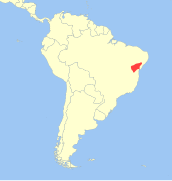
|
Size: 23–46 cm (9–18 in) long, plus 26–56 cm (10–22 in) tail[192] Habitat: Savanna and shrubland[193] Diet: Fruit, as well as leaves, vegetation, insects, eggs, and small vertebrates and invertebrates[192] |
CR
|
| Black-fronted titi monkey | C. nigrifrons (Spix, 1823) |
Eastern South America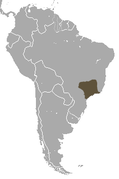
|
Size: 23–46 cm (9–18 in) long, plus 26–56 cm (10–22 in) tail[192] Habitat: Forest[194] Diet: Fruit, leaves, and flowers, as well as arthropods[194] |
NT
|
| Coastal black-handed titi monkey | C. melanochir (Wied-Neuwied, 1820) |
Eastern South America
|
Size: 23–46 cm (9–18 in) long, plus 26–56 cm (10–22 in) tail[192] Habitat: Forest[195] Diet: Fruit, seeds, and leaves[195] |
VU
|
| Coimbra Filho's titi monkey | C. coimbrai Kobayashi, 1999 |
Eastern South America
|
Size: 23–46 cm (9–18 in) long, plus 26–56 cm (10–22 in) tail[192] Habitat: Forest and savanna[196] Diet: Fruit, leaves, flowers, seeds, and insects, as well as birds[196] |
EN
|
| Common name | Scientific name and subspecies | Range | Size and ecology | IUCN status and estimated population |
|---|---|---|---|---|
| Black titi monkey | C. lugens (Humboldt, 1811) |
Northern South America
|
Size: 23–46 cm (9–18 in) long, plus 26–56 cm (10–22 in) tail[192] Habitat: Forest and savanna[197] Diet: Fruit, seeds, leaves, stems, flowers, insects, and spiders[197] |
LC
|
| Collared titi monkey
|
C. torquatus (Hoffmannsegg, 1807) |
Central South America
|
Size: 23–36 cm (9–14 in) long, plus about 46 cm (18 in) tail[198] Habitat: Forest[199] Diet: Fruit and seeds, as well as leaves and insects[198] |
LC
|
| Colombian black-handed titi monkey
|
C. medemi (Hershkovitz, 1963) |
Northwestern South America
|
Size: 23–46 cm (9–18 in) long, plus 26–56 cm (10–22 in) tail[192] Habitat: Forest[200] Diet: Fruit pulp, leaves, insects and seeds[200] |
VU
|
| Lucifer titi monkey | C. lucifer (Thomas, 1914) |
Northwestern South America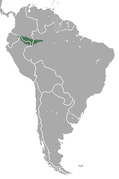
|
Size: 30–45 cm (12–18 in) long, plus 39–50 cm (15–20 in) tail[201] Habitat: Forest[202] Diet: Fruit, as well as leaves, insects, and bird eggs[201] |
LC
|
| Red-headed titi monkey
|
C. regulus (Thomas, 1927) |
Northwestern South America
|
Size: 23–46 cm (9–18 in) long, plus 26–56 cm (10–22 in) tail[192] Habitat: Forest[203] Diet: Fruit pulp, leaves, insects and seeds[203] |
LC
|
| Common name | Scientific name and subspecies | Range | Size and ecology | IUCN status and estimated population |
|---|---|---|---|---|
| Ashy black titi monkey | P. cinerascens (Spix, 1823) |
Central South America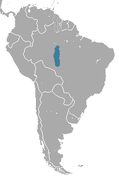
|
Size: 23–46 cm (9–18 in) long, plus 26–56 cm (10–22 in) tail[192] Habitat: Forest[204] Diet: Fruit pulp, leaves, insects and seeds[204] |
LC
|
| Baptista Lake titi monkey | P. baptista Lönnberg, 1939 |
Central South America
|
Size: 23–46 cm (9–18 in) long, plus 26–56 cm (10–22 in) tail[192] Habitat: Forest[205] Diet: Fruit pulp, leaves, insects and seeds[205] |
LC
|
| Brown titi monkey | P. brunneus (Wagner, 1842) |
West-central South America
|
Size: 23–46 cm (9–18 in) long, plus 26–56 cm (10–22 in) tail[192] Habitat: Forest[206] Diet: Fruit pulp, leaves, insects and seeds[206] |
VU
|
| Caquetá titi monkey | P. caquetensis Defler, Bueno, & García, 2010 |
Northwestern South America
|
Size: 31–34 cm (12–13 in) long, plus 36–64 cm (14–25 in) tail[207] Habitat: Forest[208] Diet: Fruit, seeds, and leaves, as well as flowers, arthropods, and stems[208] |
CR
|
| Chestnut-bellied titi monkey
|
P. caligatus (Wagner, 1842) |
Central South America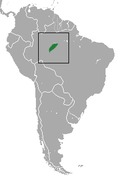
|
Size: 23–46 cm (9–18 in) long, plus 26–56 cm (10–22 in) tail[192] Habitat: Forest[209] Diet: Fruit pulp, leaves, insects and seeds[209] |
LC
|
| Coppery titi monkey | P. cupreus (Spix, 1823) |
Western South America
|
Size: 28–39 cm (11–15 in) long, plus about 7–13 cm (3–5 in) tail[210] Habitat: Forest[211] Diet: Fruit pulp, leaves, insects and seeds[211] |
LC
|
| Hershkovitz's titi monkey
|
P. dubius (Hershkovitz, 1988) |
Western South America
|
Size: 23–46 cm (9–18 in) long, plus 26–56 cm (10–22 in) tail[192] Habitat: Forest[212] Diet: Fruit pulp, leaves, insects and seeds[212] |
LC
|
| Hoffmanns's titi monkey
|
P. hoffmannsi (Thomas, 1908) |
Central South America
|
Size: 23–46 cm (9–18 in) long, plus 26–56 cm (10–22 in) tail[192] Habitat: Forest[213] Diet: Fruit pulp, leaves, insects and seeds[213] |
LC
|
| Madidi titi monkey | P. aureipalatii (Wallace, Gómez, A. M. Felton, & A. Felton, 2006) |
Western South America | Size: 29–32 cm (11–13 in) long, plus 48–53 cm (19–21 in) tail[10] Habitat: Forest[214] Diet: Fruit pulp, leaves, insects and seeds[214] |
LC
|
| Milton's titi monkey
|
P. miltoni Dalponte, Silva, & Silva Júnior, 2014 |
Central South America | Size: 23–46 cm (9–18 in) long, plus 26–56 cm (10–22 in) tail[192] Habitat: Forest[215] Diet: Fruit, as well as leaves, vegetation, insects, eggs, and small vertebrates and invertebrates[192] |
DD
|
| Olalla brothers' titi monkey
|
P. olallae Lönnberg, 1939 |
Western South America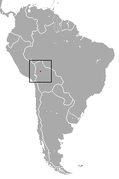
|
Size: 23–46 cm (9–18 in) long, plus 26–56 cm (10–22 in) tail[192] Habitat: Forest and savanna[216] Diet: Fruit and leaves[216] |
CR
|
| Ornate titi monkey | P. ornatus (Gray, 1866) |
Northwestern South America
|
Size: 30–36 cm (12–14 in) long, plus 38–45 cm (15–18 in) tail[217] Habitat: Forest[218] Diet: Fruit, as well as insects, leaves, and flowers[217] |
VU
|
| Prince Bernhard's titi monkey | P. bernhardi (M. van Roosmalen, T. van Roosmalen, & R. A. Mittermeier, 2002) |
Central South America
|
Size: 23–46 cm (9–18 in) long, plus 26–56 cm (10–22 in) tail[192] Habitat: Forest[219] Diet: Fruit pulp, leaves, insects and seeds[219] |
LC
|
| Red-bellied titi monkey | P. moloch (Hoffmannsegg, 1807) |
Northeast-central South America
|
Size: 27–43 cm (11–17 in) long, plus 35–55 cm (14–22 in) tail[10] Habitat: Forest[220] Diet: Fruit, as well as leaves, insects, eggs, and small vertebrates[221] |
LC
|
| Rio Beni titi monkey
|
P. modestus (Lönnberg, 1939) |
Western South America
|
Size: 23–46 cm (9–18 in) long, plus 26–56 cm (10–22 in) tail[192] Habitat: Forest and savanna[222] Diet: Fruit, as well as flowers and invertebrates[222] |
EN
|
| Rio Mayo titi monkey
|
P. oenanthe (Thomas, 1924) |
Western South America
|
Size: 23–46 cm (9–18 in) long, plus 26–56 cm (10–22 in) tail[192] Habitat: Forest[223] Diet: Fruit and insects, as well as seeds, flowers, leaves, and shoots[223] |
CR
|
| Stephen Nash's titi monkey
|
P. stephennashi M. van Roosmalen, T. van Roosmalen, & R. A. Mittermeier, 2002) |
Central South America
|
Size: 23–46 cm (9–18 in) long, plus 26–56 cm (10–22 in) tail[192] Habitat: Unknown[224] Diet: Fruit pulp, leaves, insects, and seeds[224] |
DD
|
| Toppin's titi monkey | P. toppini (Thomas, 1914) |
Western South America | Size: 23–46 cm (9–18 in) long, plus 26–56 cm (10–22 in) tail[192] Habitat: Forest[225] Diet: Fruit, as well as leaves and insects[225] |
LC
|
| Urubamba brown titi monkey | P. urubambensis (Vermeer & Tello-Alvarado, 2015) |
Western South America | Size: 23–46 cm (9–18 in) long, plus 26–56 cm (10–22 in) tail[192] Habitat: Forest[226] Diet: Fruit pulp, leaves, insects, and seeds[226] |
LC
|
| Vieira's titi monkey | P. vieirai Gualda-Barros, Nascimento, & Amaral, 2012 |
Central South America | Size: 23–46 cm (9–18 in) long, plus 26–56 cm (10–22 in) tail[192] Habitat: Forest[227] Diet: Fruit, as well as leaves, vegetation, insects, eggs, and small vertebrates and invertebrates[192] |
CR
|
| White-coated titi monkey | P. pallescens (Thomas, 1907) |
Central South America
|
Size: 23–46 cm (9–18 in) long, plus 26–56 cm (10–22 in) tail[192] Habitat: Forest and savanna[228] Diet: Fruit, flowers, and vines[228] |
LC
|
| White-eared titi monkey | P. donacophilus (d'Orbigny, 1836) |
West-central South America
|
Size: About 32 cm (13 in) long, plus 48–51 cm (19–20 in) tail[229] Habitat: Forest[230] Diet: Fruit, as well as leaves, seeds, and insects[231] |
LC
|
| White-tailed titi monkey | P. discolor (I. Geoffroy & Deville, 1848) |
Northwestern South America
|
Size: 29–45 cm (11–18 in) long, plus 35–64 cm (14–25 in) tail[232] Habitat: Forest[233] Diet: Fruit, seeds, and flowers[233] |
LC
|
Subfamily Pitheciinae
[edit]| Common name | Scientific name and subspecies | Range | Size and ecology | IUCN status and estimated population |
|---|---|---|---|---|
| Aracá uakari
|
C. ayresi Boubli et al., 2008 |
North-central South America
|
Size: 30–57 cm (12–22 in) long, plus 12–21 cm (5–8 in) tail[234] Habitat: Forest[235] Diet: Fruit, nuts, flowers, leaves, and insects[234] |
LC
|
| Golden-backed uakari | C. melanocephalus (Humboldt, 1811) |
Northern South America
|
Size: 36–49 cm (14–19 in) long, plus 18–25 cm (7–10 in) tail[236] Habitat: Forest[237] Diet: Fruit and seeds[236] |
LC
|
| Neblina uakari
|
C. hosomi Boubli et al., 2008 |
Northern South America
|
Size: 43–49 cm (17–19 in) long, plus 36–45 cm (14–18 in) tail[238] Habitat: Forest and savanna[239] Diet: Seeds, as well as fruit pulp, leaves, and arthropods[239] |
VU
|
| Novae's bald-headed uakari | C. novaesi Hershkovitz, 1987 |
Western South America | Size: 38–57 cm (15–22 in) long, plus 14–19 cm (6–7 in) tail[10] Habitat: Forest[240] Diet: Seeds, fruit, leaves, nectar, and insects[241] |
VU
|
| Red bald-headed uakari | C. rubicundus (I. Geoffroy & Deville, 1848) |
Western South America | Size: 38–57 cm (15–22 in) long, plus 14–19 cm (6–7 in) tail[10] Habitat: Forest[242] Diet: Seeds, fruit, leaves, nectar, and insects[241] |
LC
|
| Ucayali bald-headed uakari | C. ucayalii Thomas, 1928 |
Western South America | Size: 38–57 cm (15–22 in) long, plus 14–19 cm (6–7 in) tail[10] Habitat: Forest[243] Diet: Seeds, fruit, leaves, nectar, and insects[241] |
VU
|
| White bald-headed uakari | C. calvus (I. Geoffroy, 1847) |
Western South America | Size: 38–57 cm (15–22 in) long, plus 14–19 cm (6–7 in) tail[10] Habitat: Forest[244] Diet: Seeds, fruit, leaves, nectar, and insects[241] |
LC
|
| Common name | Scientific name and subspecies | Range | Size and ecology | IUCN status and estimated population |
|---|---|---|---|---|
| Black bearded saki | C. satanas (Hoffmannsegg, 1807) |
Northeastern South America
|
Size: 32–48 cm (13–19 in) long, plus 37–47 cm (15–19 in) tail[245] Habitat: Forest[246] Diet: Seeds, as well as fruit, flowers, leaf stalks, and arthropods[245] |
EN
|
| Reddish-brown bearded saki
|
C. sagulatus (Traill, 1821) |
Northeastern South America | Size: 32–52 cm (13–20 in) long, plus 30–51 cm (12–20 in) tail[247] Habitat: Forest[248] Diet: Fruit and seeds, as well as flowers, stems, and arthropods[248] |
LC
|
| Red-backed bearded saki | C. chiropotes (Humboldt, 1811) |
Northern South America
|
Size: 32–52 cm (13–20 in) long, plus 30–51 cm (12–20 in) tail[247] Habitat: Forest[249] Diet: Seeds, fruit, and nuts, as well as insects[250] |
LC
|
| Uta Hick's bearded saki | C. utahickae Hershkovitz, 1985 |
Northern South America
|
Size: 32–52 cm (13–20 in) long, plus 30–51 cm (12–20 in) tail[247] Habitat: Forest[251] Diet: Seeds, fruit, and flowers, as well as insects, leaves, and stems[251] |
VU
|
| White-nosed saki | C. albinasus (I. Geoffroy & Deville, 1848) |
Central South America
|
Size: 41–48 cm (16–19 in) long, plus 30–51 cm (12–20 in) tail[252] Habitat: Forest[253] Diet: Fruit, nuts, and insects[254] |
VU
|
| Common name | Scientific name and subspecies | Range | Size and ecology | IUCN status and estimated population |
|---|---|---|---|---|
| Burnished saki | P. inusta Spix, 1823 |
Western South America | Size: 30–71 cm (12–28 in) long, plus 25–55 cm (10–22 in) tail[255] Habitat: Forest[256] Diet: Seeds, fruit pulp, leaves, insects, and flowers[256] |
LC
|
| Cazuza's saki
|
P. cazuzai Marsh, 2014 |
Central South America | Size: 30–71 cm (12–28 in) long, plus 25–55 cm (10–22 in) tail[255] Habitat: Forest[257] Diet: Seeds, fruit pulp, leaves, insects, and flowers[257] |
DD
|
| Equatorial saki | P. aequatorialis Hershkovitz, 1987 |
Western South America
|
Size: 30–71 cm (12–28 in) long, plus 25–55 cm (10–22 in) tail[255] Habitat: Forest[258] Diet: Seeds, fruit pulp, leaves, insects, and flowers[258] |
LC
|
| Golden-faced saki | P. chrysocephala I. Geoffroy, 1850 |
Central South America | Size: 30–71 cm (12–28 in) long, plus 25–55 cm (10–22 in) tail[255] Habitat: Forest[259] Diet: Seeds, fruit pulp, leaves, insects, and flowers[259] |
LC
|
| Hairy saki | P. hirsuta Spix, 1823 |
Western South America | Size: 30–71 cm (12–28 in) long, plus 25–55 cm (10–22 in) tail[255] Habitat: Forest[260] Diet: Seeds, fruit pulp, leaves, insects, and flowers[260] |
LC
|
| Isabel's saki
|
P. isabela Marsh, 2014 |
Western South America | Size: 30–71 cm (12–28 in) long, plus 25–55 cm (10–22 in) tail[255] Habitat: Forest[261] Diet: Seeds, fruit pulp, leaves, insects, and flowers[261] |
DD
|
| Miller's saki | P. milleri Allen, 1914 |
Northwestern South America | Size: 30–71 cm (12–28 in) long, plus 25–55 cm (10–22 in) tail[255] Habitat: Forest[262] Diet: Seeds, fruit pulp, leaves, insects, and flowers[262] |
VU
|
| Monk saki | P. monachus (Geoffroy, 1812) |
Northwestern South America
|
Size: 41–50 cm (16–20 in) long, plus 40–50 cm (16–20 in) tail[34] Habitat: Forest[263] Diet: Seeds, fruit pulp, leaves, insects, and flowers[263] |
LC
|
| Napo saki | P. napensis Lönnberg, 1938 |
Northwestern South America | Size: 20–50 cm (8–20 in) long, plus 20–50 cm (8–20 in) tail[264] Habitat: Forest[265] Diet: Seeds, fruit pulp, leaves, insects, and flowers[265] |
LC
|
| Rio Tapajós saki | P. irrorata Gray, 1842 |
Central South America
|
Size: About 41 cm (16 in) long, plus about 47 cm (19 in) tail[266] Habitat: Forest[267] Diet: Seeds, fruit pulp, leaves, insects, and flowers[267] |
DD
|
| Vanzolini's bald-faced saki
|
P. vanzolinii Hershkovitz, 1987 |
West-central South America | Size: 30–71 cm (12–28 in) long, plus 25–55 cm (10–22 in) tail[255] Habitat: Forest[268] Diet: Seeds, fruit pulp, leaves, insects, and flowers[268] |
DD
|
| White-faced saki | P. pithecia (Linnaeus, 1766) |
Northern South America
|
Size: 28–46 cm (11–18 in) long, plus 32–46 cm (13–18 in) tail[34] Habitat: Forest[269] Diet: Seeds, and leaves, as well as insects and flowers[270] |
LC
|
| White-footed saki | P. albicans Gray, 1860 |
Central South America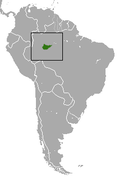
|
Size: 36–56 cm (14–22 in) long, plus 36–56 cm (14–22 in) tail[271] Habitat: Forest[272] Diet: Seeds, fruit pulp, leaves, insects, and flowers[272] |
LC
|
References
[edit]- ^ "Fossilworks: Platyrrhini". Paleobiology Database. University of Wisconsin–Madison. Retrieved October 21, 2023.
- ^ Silvestro, D.; Tejedor, M. F.; Serrano Serrano, M. L.; Loiseau, O.; Rossier, V.; Rolland, J.; Zizka, A.; Antonelli, A.; Salamin, N. (2019). "Early Arrival and Climatically-Linked Geographic Expansion of New World Monkeys from Tiny African Ancestors". Systematic Biology. 68 (1): 78–92. doi:10.1093/sysbio/syy046. PMC 6292484.
- ^ Wilson, Reeder, pp. 128–151
- ^ Smith, Candace T. (2023). "Aotus azarae". Animal Diversity Web. University of Michigan. Retrieved October 22, 2023.
- ^ a b c Rímoli, J.; Pinto, T.; Romero-Valenzuela, D.; Rumiz, D. I.; Lynch Alfaro, J. W.; Ravetta, A. L. (2021) [amended version of 2018 assessment]. "Aotus azarae". IUCN Red List of Threatened Species. 2021: e.T41539A190450485. doi:10.2305/IUCN.UK.2021-1.RLTS.T41539A190450485.en.
- ^ Covert, Tara (April 2021). "Black-Headed Night Monkey, Aotus nigriceps". New England Primate Conservancy. Retrieved October 22, 2023.
- ^ a b c Shanee, S.; Alves, S. L.; Calouro, A. M.; Lynch Alfaro, J. W.; Romero-Valenzuela, D.; Messias, M. R.; Röhe, F.; Ravetta, A. L. (2021) [amended version of 2018 assessment]. "Aotus nigriceps". IUCN Red List of Threatened Species. 2021: e.T41542A190455194. doi:10.2305/IUCN.UK.2021-1.RLTS.T41542A190455194.en.
- ^ a b c d Nowak, p. 111
- ^ a b c Carretero, X.; Guzman-Caro, D.; Stevenson, P. R. (2020). "Aotus brumbacki". IUCN Red List of Threatened Species. 2020: e.T39915A17923405. doi:10.2305/IUCN.UK.2020-2.RLTS.T39915A17923405.en.
- ^ a b c d e f g h Burnie; Wilson, p. 143
- ^ a b Link, A.; de la Torre, S.; Moscoso, P. (2021). "Aotus lemurinus". IUCN Red List of Threatened Species. 2021: e.T1808A17922601. doi:10.2305/IUCN.UK.2021-1.RLTS.T1808A17922601.en.
- ^ Soderman, Sarah (2000). "Aotus lemurinus". Animal Diversity Web. University of Michigan. Retrieved September 20, 2023.
- ^ a b c Link, A.; Urbani, B.; Mittermeier, R. A. (2021) [amended version of 2019 assessment]. "Aotus griseimembra". IUCN Red List of Threatened Species. 2021: e.T1807A190452803. doi:10.2305/IUCN.UK.2021-1.RLTS.T1807A190452803.en.
- ^ a b c Defler, T. R.; Rodríguez, J. V. (2021) [amended version of 2018 assessment]. "Aotus jorgehernandezi". IUCN Red List of Threatened Species. 2021: e.T136211A190453268. doi:10.2305/IUCN.UK.2021-1.RLTS.T136211A190453268.en.
- ^ Bahr, Laura Lee (September 2021). "Nancy Ma's Night Monkey, Aotus nancymaae". New England Primate Conservancy. Retrieved October 22, 2023.
- ^ a b Maldonado, A.; Guzmàn-Caro, D.; Shanee, S.; Defler, T. R.; Roncancio, N. (2020). "Aotus nancymaae". IUCN Red List of Threatened Species. 2020: e.T41540A115578713. doi:10.2305/IUCN.UK.2020-3.RLTS.T41540A115578713.en.
- ^ Graf, John (2006). "Aotus nancymaae". Animal Diversity Web. University of Michigan. Retrieved September 20, 2023.
- ^ Covert, Tara (May 2021). "Panamanian Night Monkey, Aotus zonalis". New England Primate Conservancy. Retrieved October 22, 2023.
- ^ a b c Méndez-Carvajal, P. G.; Link, A. (2021). "Aotus zonalis". IUCN Red List of Threatened Species. 2021: e.T39953A17922442. doi:10.2305/IUCN.UK.2021-1.RLTS.T39953A17922442.en.
- ^ a b c Shanee, S.; Cornejo, F. M.; Mittermeier, R. A. (2020) [amended version of 2019 assessment]. "Aotus miconax". IUCN Red List of Threatened Species. 2020: e.T1802A164046186. doi:10.2305/IUCN.UK.2020-1.RLTS.T1802A164046186.en.
- ^ Quinlan, K. Clare (March 2020). "Spix's Night Monkey, Aotus vociferans". New England Primate Conservancy. Retrieved October 22, 2023.
- ^ a b c Guzmán-Caro, D. C.; Lynch Alfaro, J. W.; Stevenson, P. R.; de la Torre, S.; Cornejo, F. M.; Maldonado, A.; Moscoso, P. (2021) [amended version of 2020 assessment]. "Aotus vociferans". IUCN Red List of Threatened Species. 2021: e.T41544A191682904. doi:10.2305/IUCN.UK.2021-1.RLTS.T41544A191682904.en.
- ^ a b LaValle, Alicia (2000). "Aotus trivirgatus". Animal Diversity Web. University of Michigan. Retrieved September 20, 2023.
- ^ a b Urbani, B.; de Azevedo, R. B.; Lynch Alfaro, J. W. (2021) [amended version of 2018 assessment]. "Aotus trivirgatus". IUCN Red List of Threatened Species. 2021: e.T41543A191681999. doi:10.2305/IUCN.UK.2021-1.RLTS.T41543A191681999.en.
- ^ Riley, Amanda E. (September 2023). "Amazon Black Howler, Alouatta nigerrima". New England Primate Conservancy. Retrieved October 22, 2023.
- ^ a b c Ravetta, A. L.; Sampaio, R.; Rylands, A. B.; Cortés-Ortiz, L. (2021) [amended version of 2018 assessment]. "Alouatta nigerrima". IUCN Red List of Threatened Species. 2021: e.T136332A190424175. doi:10.2305/IUCN.UK.2021-1.RLTS.T136332A190424175.en.
- ^ a b LaValle, Alicia (2000). "Alouatta caraya". Animal Diversity Web. University of Michigan. Retrieved September 20, 2023.
- ^ a b Bicca-Marques, J. C.; Rumiz, D. I.; Ludwig, G.; Rímoli, J.; Martins, V.; da Cunha, R. G. T.; Alves, S. L.; Valle, R. R.; Miranda, J. M. D.; Jerusalinsky, L.; Messias, M. R.; Cornejo, F. M.; Boubli, J. P.; Cortes-Ortíz, L.; Wallace, R. B.; Talebi, M.; de Melo, F. R. (2021) [amended version of 2020 assessment]. "Alouatta caraya". IUCN Red List of Threatened Species. 2021: e.T41545A190414715. doi:10.2305/IUCN.UK.2021-1.RLTS.T41545A190414715.en.
- ^ Botting, Jennifer (August 2021). "Bolivian Red Howler, Alouatta sara". New England Primate Conservancy. Retrieved October 22, 2023.
- ^ a b c Cornejo, F. M.; Boubli, J. P.; Alves, S. L.; Bicca-Marques, J. C.; Cortés-Ortiz, L.; Calouro, A. M.; de Melo, F. R.; Shanee, S.; Wallace, R. B. (2021). "Alouatta sara". IUCN Red List of Threatened Species. 2021: e.T41546A17924752. doi:10.2305/IUCN.UK.2021-1.RLTS.T41546A17924752.en.
- ^ a b c d e Nowak, p. 103
- ^ a b Jerusalinsky, L.; Bicca-Marques, J. C.; Neves, L. G.; Alves, S. L.; Ingberman, B.; Buss, G.; Fries, B. G.; Alonso, A. C.; da Cunha, R. G. T.; Miranda, J. M. D.; Talebi, M.; de Melo, F. R.; Mittermeier, R. A.; Cortes-Ortíz, L. (2021) [amended version of 2020 assessment]. "Alouatta guariba". IUCN Red List of Threatened Species. 2021: e.T39916A190417874. doi:10.2305/IUCN.UK.2021-1.RLTS.T39916A190417874.en.
- ^ Arslanian, Kendall (2011). "Alouatta guariba". Animal Diversity Web. University of Michigan. Retrieved September 20, 2023.
- ^ a b c d Burnie; Wilson, p. 142
- ^ a b Link, A.; Palacios, E.; Cortés-Ortiz, L.; Stevenson, P. R.; Cornejo, F. M.; Mittermeier, R. A.; Shanee, S.; de la Torre, S.; Boubli, J. P.; Guzmán-Caro, D. C.; Moscoso, P.; Urbani, B.; Seyjagat, J. (2021). "Alouatta seniculus". IUCN Red List of Threatened Species. 2021: e.T198676562A198687134. doi:10.2305/IUCN.UK.2021-2.RLTS.T198676562A198687134.en.
- ^ Normile, Rebecca V. (2001). "Alouatta seniculus". Animal Diversity Web. University of Michigan. Retrieved September 20, 2023.
- ^ a b c Boubli, J. P.; Urbani, B. (2021). "Alouatta macconnelli". IUCN Red List of Threatened Species. 2021: e.T198622924A198669499. doi:10.2305/IUCN.UK.2021-2.RLTS.T198622924A198669499.en.
- ^ a b Schoville, Sean (2000). "Alouatta palliata". Animal Diversity Web. University of Michigan. Retrieved September 20, 2023.
- ^ a b Cortes-Ortíz, L.; Rosales-Meda, M.; Williams-Guillén, K.; Solano-Rojas, D.; Méndez-Carvajal, P. G.; de la Torre, S.; Moscoso, P.; Rodríguez, V.; Palacios, E.; Canales-Espinosa, D.; Link, A.; Guzman-Caro, D.; Cornejo, F. M. (2021) [amended version of 2020 assessment]. "Alouatta palliata". IUCN Red List of Threatened Species. 2021: e.T39960A190425583. doi:10.2305/IUCN.UK.2021-1.RLTS.T39960A190425583.en.
- ^ a b c Fialho, M. S.; Jerusalinsky, L.; Ferreira, J. G.; Pinto, T.; Laroque, P. O.; Cortes-Ortíz, L.; Freire Filho, R. (2021). "Alouatta ululata". IUCN Red List of Threatened Species. 2021: e.T918A190435652. doi:10.2305/IUCN.UK.2021-1.RLTS.T918A190435652.en.
- ^ a b Wallen, Meg; Lande, Jenna (2009). "Alouatta belzebul". Animal Diversity Web. University of Michigan. Retrieved September 20, 2023.
- ^ a b Valença-Montenegro, M. M.; Fialho, M. S.; Carvalho, A. S.; Ravetta, A. L.; Régis, T.; de Melo, F. R.; Jerusalinsky, L.; Veiga, L. M.; Mittermeier, R. A.; Cortes-Ortíz, L.; Talebi, M. (2021) [amended version of 2019 assessment]. "Alouatta belzebul". IUCN Red List of Threatened Species. 2021: e.T39957A190412426. doi:10.2305/IUCN.UK.2021-1.RLTS.T39957A190412426.en.
- ^ a b c Pinto, L. P.; Ravetta, A. L.; Buss, G.; Veiga, L. M.; de Melo, F. R. (2021) [amended version of 2020 assessment]. "Alouatta discolor". IUCN Red List of Threatened Species. 2021: e.T43912A190416507. doi:10.2305/IUCN.UK.2021-1.RLTS.T43912A190416507.en.
- ^ a b c Urbani, B.; Boubli, J. P.; Cortes-Ortíz, L. (2021) [amended version of 2018 assessment]. "Alouatta arctoidea". IUCN Red List of Threatened Species. 2021: e.T136486A190413988. doi:10.2305/IUCN.UK.2021-1.RLTS.T136486A190413988.en.
- ^ a b Cortes-Ortíz, L.; Rosales-Meda, M.; Marsh, L. K.; Mittermeier, R. A. (2020). "Alouatta pigra". IUCN Red List of Threatened Species. 2020: e.T914A17926000. doi:10.2305/IUCN.UK.2020-3.RLTS.T914A17926000.en.
- ^ Lau, Kimberly (2007). "Alouatta pigra". Animal Diversity Web. University of Michigan. Retrieved September 20, 2023.
- ^ a b Cifranic, Bryan (2002). "Ateles fusciceps". Animal Diversity Web. University of Michigan. Retrieved September 20, 2023.
- ^ a b Moscoso, P.; Link, A.; Defler, T. R.; de la Torre, S.; Cortes-Ortíz, L.; Méndez-Carvajal, P. G.; Shanee, S. (2021) [amended version of 2020 assessment]. "Ateles fusciceps". IUCN Red List of Threatened Species. 2021: e.T135446A191687087. doi:10.2305/IUCN.UK.2021-1.RLTS.T135446A191687087.en.
- ^ a b Burnie; Wilson, p. 141
- ^ a b Link, A.; Urbani, B.; Stevenson, P. R.; Mittermeier, R. A. (2020). "Ateles hybridus". IUCN Red List of Threatened Species. 2020: e.T39961A17929680. doi:10.2305/IUCN.UK.2020-2.RLTS.T39961A17929680.en.
- ^ Thunstrom, Maria (2009). "Ateles hybridus". Animal Diversity Web. University of Michigan. Retrieved September 20, 2023.
- ^ a b Gorog, Antonia (2002). "Ateles geoffroyi". Animal Diversity Web. University of Michigan. Retrieved September 20, 2023.
- ^ a b Cortes-Ortíz, L.; Solano-Rojas, D.; Rosales-Meda, M.; Williams-Guillén, K.; Méndez-Carvajal, P. G.; Marsh, L. K.; Canales-Espinosa, D.; Mittermeier, R. A. (2021) [amended version of 2020 assessment]. "Ateles geoffroyi". IUCN Red List of Threatened Species. 2021: e.T2279A191688782. doi:10.2305/IUCN.UK.2021-1.RLTS.T2279A191688782.en.
- ^ a b Alves, S. L.; Ravetta, A. L.; Paim, F. P.; Mittermeier, R. A.; Rabelo, R. M.; Wallace, R. B.; Messias, M. R.; Calouro, A. M.; Rylands, A. B.; de Melo, F. R.; Boubli, J. P. (2021) [amended version of 2020 assessment]. "Ateles chamek". IUCN Red List of Threatened Species. 2021: e.T41547A191685783. doi:10.2305/IUCN.UK.2021-1.RLTS.T41547A191685783.en.
- ^ Kademian, Sylvie (2016). "Ateles chamek". Animal Diversity Web. University of Michigan. Retrieved September 20, 2023.
- ^ a b Nowak, p. 100
- ^ a b Mittermeier, R. A.; Boubli, J. P.; Urbani, B.; Régis, T.; de Melo, F. R. (2021) [amended version of 2019 assessment]. "Ateles paniscus". IUCN Red List of Threatened Species. 2021: e.T2283A191691902. doi:10.2305/IUCN.UK.2021-1.RLTS.T2283A191691902.en.
- ^ Kanter, Tessah (2011). "Ateles paniscus". Animal Diversity Web. University of Michigan. Retrieved September 20, 2023.
- ^ Ceitlin, Jill (2004). "Ateles belzebuth". Animal Diversity Web. University of Michigan. Retrieved October 22, 2023.
- ^ a b c Link, A.; Palacios, E.; Stevenson, P. R.; Boubli, J. P.; Mittermeier, R. A.; Shanee, S.; Urbani, B.; de la Torre, S.; Cornejo, F. M.; Moscoso, P.; Mourthé, Í.; Muniz, C. C.; Rylands, A. B. (2021) [amended version of 2019 assessment]. "Ateles belzebuth". IUCN Red List of Threatened Species. 2021: e.T2276A191684587. doi:10.2305/IUCN.UK.2021-1.RLTS.T2276A191684587.en.
- ^ a b c Ravetta, A. L.; Buss, G.; Mittermeier, R. A. (2021) [amended version of 2019 assessment]. "Ateles marginatus". IUCN Red List of Threatened Species. 2021: e.T2282A191689524. doi:10.2305/IUCN.UK.2021-1.RLTS.T2282A191689524.en.
- ^ a b c Edkins, Tera (2014). "Brachyteles hypoxanthus". Animal Diversity Web. University of Michigan. Retrieved September 20, 2023.
- ^ a b de Melo, F. R.; Boubli, J. P.; Mittermeier, R. A.; Jerusalinsky, L.; Tabacow, F. P.; Ferraz, D. S.; Talebi, M. (2021) [amended version of 2019 assessment]. "Brachyteles hypoxanthus". IUCN Red List of Threatened Species. 2021: e.T2994A191693399. doi:10.2305/IUCN.UK.2021-1.RLTS.T2994A191693399.en.
- ^ a b Talebi, M.; Jerusalinsky, L.; Martins, M.; Mittermeier, R. A.; Ingberman, B.; Ferraz, D. S.; de Melo, F. R.; Boubli, J. P. (2021) [amended version of 2019 assessment]. "Brachyteles arachnoides". IUCN Red List of Threatened Species. 2021: e.T2993A191692658. doi:10.2305/IUCN.UK.2021-1.RLTS.T2993A191692658.en.
- ^ Bladh, Anni (2003). "Brachyteles arachnoides". Animal Diversity Web. University of Michigan. Retrieved October 4, 2023.
- ^ a b Stone, Ivan (2001). "Lagothrix lagotricha". Animal Diversity Web. University of Michigan. Retrieved September 20, 2023.
- ^ a b Stevenson, P. R.; Defler, T. R.; de la Torre, S.; Moscoso, P.; Palacios, E.; Ravetta, A. L.; Vermeer, J.; Link, A.; Urbani, B.; Cornejo, F. M.; Guzmán-Caro, D. C.; Shanee, S.; Mourthé, Í.; Muniz, C. C.; Wallace, R. B.; Rylands, A. B. (2021) [amended version of 2020 assessment]. "Lagothrix lagothricha". IUCN Red List of Threatened Species. 2021: e.T160881218A192309103. doi:10.2305/IUCN.UK.2021-1.RLTS.T160881218A192309103.en.
- ^ Botting, Jennifer (April 2020). "Peruvian Yellow-Tailed Wooly Monkey, Lagothrix flavicauda". New England Primate Conservancy. Retrieved October 22, 2023.
- ^ a b c Shanee, S.; Cornejo, F. M.; Aquino, R.; Mittermeier, R. A.; Vermeer, J. (2021) [amended version of 2019 assessment]. "Lagothrix flavicauda". IUCN Red List of Threatened Species. 2021: e.T39924A192307818. doi:10.2305/IUCN.UK.2021-1.RLTS.T39924A192307818.en.
- ^ a b Maffei, Devin (2023). "Callimico goeldii". Animal Diversity Web. University of Michigan. Retrieved September 20, 2023.
- ^ a b Palacios, E.; Wallace, R. B.; Mollinedo, J. M.; Heymann, E. W.; Shanee, S.; Calouro, A. M.; del Valle, E.; Mittermeier, R. A. (2021) [amended version of 2020 assessment]. "Callimico goeldii". IUCN Red List of Threatened Species. 2021: e.T3564A191700340. doi:10.2305/IUCN.UK.2021-1.RLTS.T3564A191700340.en.
- ^ Lussier, Zachary (September 2019). "Black-Tufted Marmoset, Callithrix penicillata". New England Primate Conservancy. Retrieved October 22, 2023.
- ^ a b Valle, R. R.; Ruiz-Miranda, C. R.; Pereira, D. G.; Rímoli, J.; Bicca-Marques, J. C.; Jerusalinsky, L.; Valença-Montenegro, M. M.; Mittermeier, R. A. (2021) [amended version of 2018 assessment]. "Callithrix penicillata". IUCN Red List of Threatened Species. 2021: e.T41519A191705321. doi:10.2305/IUCN.UK.2021-1.RLTS.T41519A191705321.en.
- ^ Ackley, Valerie (2004). "Callithrix penicillata". Animal Diversity Web. University of Michigan. Retrieved September 20, 2023.
- ^ a b Throckmorton, Zachary (2003). "Callithrix flaviceps". Animal Diversity Web. University of Michigan. Retrieved September 20, 2023.
- ^ a b de Melo, F. R.; Hilário, R. R.; Ferraz, D. S.; Pereira, D. G.; Bicca-Marques, J. C.; Jerusalinsky, L.; Mittermeier, R. A.; Ruiz-Miranda, C. R.; Oliveira, L.; Valença-Montenegro, M. M. (2021) [amended version of 2020 assessment]. "Callithrix flaviceps". IUCN Red List of Threatened Species. 2021: e.T3571A191700879. doi:10.2305/IUCN.UK.2021-1.RLTS.T3571A191700879.en.
- ^ a b c d e f g h i j k l m n o p Nowak, p. 124
- ^ a b de Melo, F. R.; Port-Carvalho, M.; Pereira, D. G.; Ruiz-Miranda, C. R.; Ferraz, D. S.; Bicca-Marques, J. C.; Jerusalinsky, L.; Oliveira, L. C.; Valença-Montenegro, M. M.; Valle, R. R.; da Cunha, R. G. T.; Mittermeier, R. A. (2021) [amended version of 2020 assessment]. "Callithrix aurita". IUCN Red List of Threatened Species. 2021: e.T3570A191700629. doi:10.2305/IUCN.UK.2021-1.RLTS.T3570A191700629.en.
- ^ Kuo, Michael (2000). "Callithrix aurita". Animal Diversity Web. University of Michigan. Retrieved September 20, 2023.
- ^ a b Cover, Sarah (2000). "Callithrix jacchus". Animal Diversity Web. University of Michigan. Retrieved September 20, 2023.
- ^ a b Valença-Montenegro, M. M.; Bezerra, B. M.; Ruiz-Miranda, C. R.; Pereira, D. G.; Miranda, J. M. D.; Bicca-Marques, J. C.; Oliveira, L.; da Cruz, M. A. O. M.; Valle, R. R.; Mittermeier, R. A. (2021) [amended version of 2018 assessment]. "Callithrix jacchus". IUCN Red List of Threatened Species. 2021: e.T41518A191705043. doi:10.2305/IUCN.UK.2021-1.RLTS.T41518A191705043.en.
- ^ a b c d Burnie; Wilson, p. 145
- ^ a b de Melo, F. R.; Pereira, D. G.; Kierulff, M. C. M.; Bicca-Marques, J. C.; Mittermeier, R. A. (2021) [amended version of 2018 assessment]. "Callithrix geoffroyi". IUCN Red List of Threatened Species. 2021: e.T3572A191701212. doi:10.2305/IUCN.UK.2021-1.RLTS.T3572A191701212.en.
- ^ Murphy, Brittany (2009). "Callithrix geoffroyi". Animal Diversity Web. University of Michigan. Retrieved September 20, 2023.
- ^ Covert, Rara (September 2020). "Wied's Marmoset, Callithrix kuhlii". New England Primate Conservancy. Retrieved October 22, 2023.
- ^ a b Neves, L. G.; Jerusalinsky, L.; Pereira, D. G.; Bicca-Marques, J. C.; Rylands, A. B.; Mittermeier, R. A. (2021) [amended version of 2019 assessment]. "Callithrix kuhlii". IUCN Red List of Threatened Species. 2021: e.T3575A191701453. doi:10.2305/IUCN.UK.2021-1.RLTS.T3575A191701453.en.
- ^ Keeley, Theresa (2004). "Callithrix kuhlii". Animal Diversity Web. University of Michigan. Retrieved September 20, 2023.
- ^ a b c de la Torre, S.; Calouro, A. M.; Wallace, R. B.; Mollinedo, J. M.; Messias, M. R.; Valença-Montenegro, M. M. (2021) [amended version of 2020 assessment]. "Cebuella niveiventris". IUCN Red List of Threatened Species. 2021: e.T136865A191707236. doi:10.2305/IUCN.UK.2021-1.RLTS.T136865A191707236.en.
- ^ a b de la Torre, S.; Shanee, S.; Palacios, E.; Calouro, A. M.; Messias, M. R.; Valença-Montenegro, M. M. (2021) [amended version of 2021 assessment]. "Cebuella pygmaea". IUCN Red List of Threatened Species. 2021: e.T136926A200203263. doi:10.2305/IUCN.UK.2021-2.RLTS.T136926A200203263.en.
- ^ Wade, Edward (2012). "Callithrix pygmaea". Animal Diversity Web. University of Michigan. Retrieved September 20, 2023.
- ^ a b c d e f g h i j k l m n o Nowak, p. 121
- ^ a b c Heymann, E. W.; Shanee, S. (2020). "Leontocebus leucogenys". IUCN Red List of Threatened Species. 2020: e.T19826A17980550. doi:10.2305/IUCN.UK.2020-3.RLTS.T19826A17980550.en.
- ^ a b Sampaio, R.; Rohe, F.; Rylands, A. B. (2020). "Leontocebus cruzlimai". IUCN Red List of Threatened Species. 2020: e.T19829A17980514. doi:10.2305/IUCN.UK.2020-3.RLTS.T19829A17980514.en.
- ^ a b c Heymann, E. W. (2020). "Leontocebus nigrifrons". IUCN Red List of Threatened Species. 2020: e.T43953A17980422. doi:10.2305/IUCN.UK.2020-3.RLTS.T43953A17980422.en.
- ^ a b c Heymann, E. W.; Shanee, S.; Mittermeier, R. A. (2020). "Leontocebus illigeri". IUCN Red List of Threatened Species. 2020: e.T43952A17980750. doi:10.2305/IUCN.UK.2020-3.RLTS.T43952A17980750.en.
- ^ a b c Palacios, E.; Spironello, W. (2020). "Leontocebus fuscus". IUCN Red List of Threatened Species. 2020: e.T42693A17980668. doi:10.2305/IUCN.UK.2020-3.RLTS.T42693A17980668.en.
- ^ a b c Heymann, E. W.; de la Torre, S.; Mittermeier, R. A. (2020). "Leontocebus lagonotus". IUCN Red List of Threatened Species. 2020: e.T43950A17980627. doi:10.2305/IUCN.UK.2020-3.RLTS.T43950A17980627.en.
- ^ Lussier, Zachary (September 2021). "Weddel's Saddle-Back Tamarin, Leontocebus weddelli". New England Primate Conservancy. Retrieved October 22, 2023.
- ^ a b c Ravetta, A. L.; Heymann, E. W.; Rylands, A. B.; Calouro, A. M.; Messias, M. R.; Alves, S. L.; Wallace, R. B.; Mollinedo, J. M.; Mittermeier, R. A. (2021) [amended version of 2020 assessment]. "Leontocebus weddelli". IUCN Red List of Threatened Species. 2021: e.T160939221A192315781. doi:10.2305/IUCN.UK.2021-1.RLTS.T160939221A192315781.en.
- ^ a b Gray, Douglas (2003). "Leontopithecus chrysopygus". Animal Diversity Web. University of Michigan. Retrieved September 20, 2023.
- ^ a b Rezende, G.; Knogge, C.; Passos, F.; Ludwig, G.; Oliveira, L. C.; Jerusalinsky, L.; Mittermeier, R. A. (2020). "Leontopithecus chrysopygus". IUCN Red List of Threatened Species. 2020: e.T11505A17935400. doi:10.2305/IUCN.UK.2020-2.RLTS.T11505A17935400.en.
- ^ a b Frantom, Sarah (1999). "Leontopithecus rosalia". Animal Diversity Web. University of Michigan. Retrieved September 20, 2023.
- ^ a b Ruiz-Miranda, C. R.; Pissinatti, A.; Kierulff, M. C. M.; Oliveira, L. C.; Mittermeier, R. A.; Valença-Montenegro, M. M.; de Oliveira, P.; Jerusalinsky, L. (2021) [amended version of 2019 assessment]. "Leontopithecus rosalia". IUCN Red List of Threatened Species. 2021: e.T11506A192327291. doi:10.2305/IUCN.UK.2021-1.RLTS.T11506A192327291.en.
- ^ a b Lundrigan, Barbara; Kapheim, Karen (2000). "Leontopithecus chrysomelas". Animal Diversity Web. University of Michigan. Retrieved October 16, 2023.
- ^ a b Oliveira, L. C.; Neves, L. G.; Kierulff, M. C. M.; Jerusalinsky, L.; Mittermeier, R. A.; Rylands, A. B. (2021) [amended version of 2020 assessment]. "Leontopithecus chrysomelas". IUCN Red List of Threatened Species. 2021: e.T40643A192327573. doi:10.2305/IUCN.UK.2021-1.RLTS.T40643A192327573.en.
- ^ Downey, Kathleen (September 2022). "Black-Faced Lion Tamarin, Leontopithecus caissara". New England Primate Conservancy. Retrieved October 22, 2023.
- ^ a b Ludwig, G.; Nascimento, A. T. A.; Miranda, J. M. D.; Martins, M.; Jerusalinsky, L.; Mittermeier, R. A. (2021). "Leontopithecus caissara". IUCN Red List of Threatened Species. 2021: e.T11503A206547044. doi:10.2305/IUCN.UK.2021-3.RLTS.T11503A206547044.en.
- ^ Martin, Pam (2003). "Leontopithecus caissara". Animal Diversity Web. University of Michigan. Retrieved September 20, 2023.
- ^ a b c Muniz, C.; Rohe, F. (2019). "Mico nigriceps". IUCN Red List of Threatened Species. 2019: e.T39913A17934547. doi:10.2305/IUCN.UK.2019-3.RLTS.T39913A17934547.en.
- ^ a b Milagres, A. P.; Rímoli, J.; dos Santos, M. C.; Wallace, R. B.; Rumiz, D. I.; Mollinedo, J. M.; Rylands, A. B. (2021) [amended version of 2020 assessment]. "Mico melanurus". IUCN Red List of Threatened Species. 2021: e.T136294A192400781. doi:10.2305/IUCN.UK.2021-1.RLTS.T136294A192400781.en.
- ^ Scott, Robyn (October 2023). "Emilia's Marmoset, Mico emiliae". New England Primate Conservancy. Retrieved October 22, 2023.
- ^ a b c Canale, G. R.; Fialho, M. S.; Rylands, A. B. (2021) [amended version of 2018 assessment]. "Mico emiliae". IUCN Red List of Threatened Species. 2021: e.T42691A192400402. doi:10.2305/IUCN.UK.2021-1.RLTS.T42691A192400402.en.
- ^ a b Phan, Jeremy (2007). "Callithrix chrysoleuca". Animal Diversity Web. University of Michigan. Retrieved September 20, 2023.
- ^ a b Röhe, F.; Mittermeier, R. A. (2021) [amended version of 2018 assessment]. "Mico chrysoleucos". IUCN Red List of Threatened Species. 2021: e.T39910A192399226. doi:10.2305/IUCN.UK.2021-1.RLTS.T39910A192399226.en.
- ^ a b c Rylands, A. B.; Régis, T. (2018). "Mico intermedius". IUCN Red List of Threatened Species. 2018: e.T39911A17934268. doi:10.2305/IUCN.UK.2018-2.RLTS.T39911A17934268.en.
- ^ a b c Silva, F. E.; Bicca-Marques, J. C. (2021). "Mico marcai". IUCN Red List of Threatened Species. 2021: e.T39914A206547867. doi:10.2305/IUCN.UK.2021-3.RLTS.T39914A206547867.en.
- ^ a b c d Mittermeier, R. A.; Alonso, A. C.; Régis, T. (2021) [amended version of 2020 assessment]. "Mico mauesi". IUCN Red List of Threatened Species. 2021: e.T41583A192400226. doi:10.2305/IUCN.UK.2021-1.RLTS.T41583A192400226.en.
- ^ a b Costa-Araújo, R.; Farias, I.; Hrbek, T. (2020). "Mico munduruku". IUCN Red List of Threatened Species. 2020: e.T172269376A172269630. doi:10.2305/IUCN.UK.2020-2.RLTS.T172269376A172269630.en.
- ^ a b c Moura, E. F.; Mittermeier, R. A. (2021) [amended version of 2018 assessment]. "Mico acariensis". IUCN Red List of Threatened Species. 2021: e.T41580A192400051. doi:10.2305/IUCN.UK.2021-1.RLTS.T41580A192400051.en.
- ^ a b c Messias, M. R.; Valença-Montenegro, M. M.; Ferrari, S. F. (2021) [amended version of 2019 assessment]. "Mico rondoni". IUCN Red List of Threatened Species. 2021: e.T136804A192401067. doi:10.2305/IUCN.UK.2021-1.RLTS.T136804A192401067.en.
- ^ a b c Mittermeier, R. A.; Röhe, F. (2021) [amended version of 2018 assessment]. "Callibella humilis". IUCN Red List of Threatened Species. 2021: e.T41584A191706209. doi:10.2305/IUCN.UK.2021-1.RLTS.T41584A191706209.en.
- ^ a b c Buss, G.; Ravetta, A. L.; Mittermeier, R. A. (2021) [amended version of 2020 assessment]. "Mico humeralifer". IUCN Red List of Threatened Species. 2021: e.T41521A192399834. doi:10.2305/IUCN.UK.2021-1.RLTS.T41521A192399834.en.
- ^ a b c Régis, T.; Alonso, A. C.; Mittermeier, R. A. (2021) [amended version of 2018 assessment]. "Mico saterei". IUCN Red List of Threatened Species. 2021: e.T42692A192400614. doi:10.2305/IUCN.UK.2021-1.RLTS.T42692A192400614.en.
- ^ a b Costa-Araújo, R.; Silva Júnior, J. S.; Canale, G. R.; Melo, F. R.; Boubli, J. P.; Farias, I.; Hrbek, T. (2022) [errata version of 2022 assessment]. "Mico schneideri". IUCN Red List of Threatened Species. 2022: e.T210363264A222945240. doi:10.2305/IUCN.UK.2022-1.RLTS.T210363264A222945240.en.
- ^ a b Ravetta, A. L.; Rylands, A. B.; Muniz, C. C. (2021) [amended version of 2018 assessment]. "Mico argentatus". IUCN Red List of Threatened Species. 2021: e.T41520A192399613. doi:10.2305/IUCN.UK.2021-1.RLTS.T41520A192399613.en.
- ^ Garza, Rhonda (2001). "Callithrix argentata". Animal Diversity Web. University of Michigan. Retrieved October 16, 2023.
- ^ a b c d Ravetta, A. L.; Buss, G.; Fialho, M. S.; Jerusalinsky, L.; Mittermeier, R. A. (2021). "Mico leucippe". IUCN Red List of Threatened Species. 2021: e.T39912A17934089. doi:10.2305/IUCN.UK.2021-1.RLTS.T39912A17934089.en.
- ^ Downey, Kathleen (April 2021). "Saddle-Back Tamarin, Leontocebus fuscicollis". New England Primate Conservancy. Retrieved October 22, 2023.
- ^ a b c Heymann, E. W.; Ravetta, A. L.; Mittermeier, R. A.; Alonso, A. C.; Moura, E. F. (2021) [amended version of 2020 assessment]. "Leontocebus fuscicollis". IUCN Red List of Threatened Species. 2021: e.T160885500A192315580. doi:10.2305/IUCN.UK.2021-1.RLTS.T160885500A192315580.en.
- ^ a b Eggert, Hayley (2002). "Saguinus nigricollis". Animal Diversity Web. University of Michigan. Retrieved September 20, 2023.
- ^ a b de la Torre, S.; Heymann, E. W.; Mittermeier, R. A.; Muniz, C. (2020). "Leontocebus nigricollis". IUCN Red List of Threatened Species. 2020: e.T39945A17932254. doi:10.2305/IUCN.UK.2020-3.RLTS.T39945A17932254.en.
- ^ a b c Mendes-Oliveira, A. C.; Ravetta, A. L.; Carvalho, A. S.; Fialho, M. S.; Veiga, L. M. (2021) [amended version of 2020 assessment]. "Saguinus niger". IUCN Red List of Threatened Species. 2021: e.T160901052A192553958. doi:10.2305/IUCN.UK.2021-1.RLTS.T160901052A192553958.en.
- ^ a b Rodríguez, V.; Link, A.; Guzman-Caro, D.; Defler, T. R.; Palacios, E.; Stevenson, P. R.; Mittermeier, R. A. (2021) [amended version of 2020 assessment]. "Saguinus oedipus". IUCN Red List of Threatened Species. 2021: e.T19823A192551067. doi:10.2305/IUCN.UK.2021-1.RLTS.T19823A192551067.en.
- ^ Bridgeman, Brian (2002). "Saguinus oedipus". Animal Diversity Web. University of Michigan. Retrieved September 20, 2023.
- ^ a b c Mendes-Oliveira, A. C.; Ravetta, A. L.; Carvalho, A. S.; Fialho, M. S.; Veiga, L. M. (2021) [amended version of 2020 assessment]. "Saguinus ursulus". IUCN Red List of Threatened Species. 2021: e.T70610874A192553791. doi:10.2305/IUCN.UK.2021-1.RLTS.T70610874A192553791.en.
- ^ a b Eaton, Taryn (1999). "Saguinus imperator". Animal Diversity Web. University of Michigan. Retrieved September 20, 2023.
- ^ a b Ravetta, A. L.; Calouro, A. M.; Wallace, R. B.; Mollinedo, J.; Röhe, F.; Bicca-Marques, J. C.; Heymann, E. W.; Mittermeier, R. A. (2022) [amended version of 2021 assessment]. "Saguinus imperator". IUCN Red List of Threatened Species. 2022: e.T39948A213569049. doi:10.2305/IUCN.UK.2022-1.RLTS.T39948A213569049.en.
- ^ Frey, Dayna (2000). "Saguinus geoffroyi". Animal Diversity Web. University of Michigan. Retrieved October 22, 2023.
- ^ a b c Link, A.; Méndez-Carvajal, P. G.; Palacios, E.; Mittermeier, R. A. (2021) [amended version of 2019 assessment]. "Saguinus geoffroyi". IUCN Red List of Threatened Species. 2021: e.T41522A192551955. doi:10.2305/IUCN.UK.2021-1.RLTS.T41522A192551955.en.
- ^ Cloyd, Emily (2000). "Saguinus midas". Animal Diversity Web. University of Michigan. Retrieved October 22, 2023.
- ^ a b c Mittermeier, R. A.; Urbani, B.; Rylands, A. B.; Régis, T. (2021) [amended version of 2018 assessment]. "Saguinus midas". IUCN Red List of Threatened Species. 2021: e.T41525A192552538. doi:10.2305/IUCN.UK.2021-1.RLTS.T41525A192552538.en.
- ^ Carter, Justin; Hall, Lauren (2009). "Saguinus tripartitus". Animal Diversity Web. University of Michigan. Retrieved October 22, 2023.
- ^ a b c de la Torre, S.; Heymann, E. W.; Rylands, A. B. (2020). "Leontocebus tripartitus". IUCN Red List of Threatened Species. 2020: e.T19824A17930113. doi:10.2305/IUCN.UK.2020-3.RLTS.T19824A17930113.en.
- ^ a b c de Melo, F. R.; Röhe, F.; Oliveira, L.; Boubli, J. P.; Mittermeier, R. A. (2021) [amended version of 2019 assessment]. "Saguinus martinsi". IUCN Red List of Threatened Species. 2021: e.T42695A192552857. doi:10.2305/IUCN.UK.2021-1.RLTS.T42695A192552857.en.
- ^ a b c Palacios, E.; Röhe, F.; Stevenson, P. R.; Urbani, B. (2021) [amended version of 2018 assessment]. "Saguinus inustus". IUCN Red List of Threatened Species. 2021: e.T41523A192552160. doi:10.2305/IUCN.UK.2021-1.RLTS.T41523A192552160.en.
- ^ Abrams, Sylvie (August 2019). "Moustached Tamarin, Saguinus mystax". New England Primate Conservancy. Retrieved October 22, 2023.
- ^ a b Heymann, E. W.; Ravetta, A. L.; Röhe, F.; Mittermeier, R. A.; Rylands, A. B. (2021) [amended version of 2018 assessment]. "Saguinus mystax". IUCN Red List of Threatened Species. 2021: e.T41526A192552706. doi:10.2305/IUCN.UK.2021-1.RLTS.T41526A192552706.en.
- ^ Lim, Jayne (2011). "Saguinus mystax". Animal Diversity Web. University of Michigan. Retrieved September 20, 2023.
- ^ a b Kutschera, Rachel (2004). "Saguinus bicolor". Animal Diversity Web. University of Michigan. Retrieved September 20, 2023.
- ^ a b Gordo, M.; Röhe, F.; Vidal, M. D.; Subirá, R.; Boubli, J. P.; Mittermeier, R. A.; Jerusalinsky, L. (2021) [amended version of 2019 assessment]. "Saguinus bicolor". IUCN Red List of Threatened Species. 2021: e.T40644A192551696. doi:10.2305/IUCN.UK.2021-1.RLTS.T40644A192551696.en.
- ^ a b c Ravetta, A.; Rohe, F. (2020). "Saguinus mystax ssp. pileatus". IUCN Red List of Threatened Species. 2020: e.T43957A17981034. doi:10.2305/IUCN.UK.2020-3.RLTS.T43957A17981034.en.
- ^ a b c Link, A.; Guzmán-Caro, D. C.; Roncancio, N.; Mittermeier, R. A.; Rodríguez, V. (2021) [amended version of 2020 assessment]. "Saguinus leucopus". IUCN Red List of Threatened Species. 2021: e.T19819A192550769. doi:10.2305/IUCN.UK.2021-1.RLTS.T19819A192550769.en.
- ^ a b Calouro, A. M.; Röhe, F.; Messias, M. R.; Wallace, R. B.; Spironello, W. R.; Mollinedo, J. M.; Heymann, E. W.; Rylands, A. B. (2021) [amended version of 2018 assessment]. "Saguinus labiatus". IUCN Red List of Threatened Species. 2021: e.T41524A192552331. doi:10.2305/IUCN.UK.2021-1.RLTS.T41524A192552331.en.
- ^ Kristofik, Nina (2011). "Saguinus labiatus". Animal Diversity Web. University of Michigan. Retrieved September 20, 2023.
- ^ a b c Rylands, A. B.; Mittermeier, R. A. (2008). "Saguinus melanoleucus". IUCN Red List of Threatened Species. 2008: e.T135429A4128407. doi:10.2305/IUCN.UK.2008.RLTS.T135429A4128407.en.
- ^ Downey, Kathleen (July 2016). "Columbian White-Throated Capuchin, Cebus capucinus". New England Primate Conservancy. Retrieved October 22, 2023.
- ^ a b de la Torre, S.; Moscoso, P.; Méndez-Carvajal, P. G.; Rosales-Meda, M.; Palacios, E.; Link, A.; Lynch Alfaro, J. W.; Mittermeier, R. A. (2021) [amended version of 2020 assessment]. "Cebus capucinus". IUCN Red List of Threatened Species. 2021: e.T81257277A191708164. doi:10.2305/IUCN.UK.2021-1.RLTS.T81257277A191708164.en.
- ^ Long, John (2009). "Cebus capucinus". Animal Diversity Web. University of Michigan. Retrieved September 20, 2023.
- ^ a b c d Nowak, p. 113
- ^ a b c Fialho, M. S.; Jerusalinsky, L.; Moura, E. F.; Ravetta, A. L.; Laroque, P. O.; de Queiroz, H. L.; Boubli, J. P.; Lynch Alfaro, J. W. (2021) [amended version of 2020 assessment]. "Cebus kaapori". IUCN Red List of Threatened Species. 2021: e.T40019A191704766. doi:10.2305/IUCN.UK.2021-1.RLTS.T40019A191704766.en.
- ^ a b Burnie; Wilson, p. 144
- ^ a b Boubli, J. P.; Urbani, B.; Lynch Alfaro, J. W.; Laroque, P. O. (2021) [amended version of 2020 assessment]. "Cebus olivaceus". IUCN Red List of Threatened Species. 2021: e.T81384371A191708662. doi:10.2305/IUCN.UK.2021-1.RLTS.T81384371A191708662.en.
- ^ Schober, Nathan (2003). "Cebus olivaceus". Animal Diversity Web. University of Michigan. Retrieved September 20, 2023.
- ^ Cherian, Acima (April 2023). "Humboldt's White-Fronted Capuchin, Cebus albifrons". New England Primate Conservancy. Retrieved October 22, 2023.
- ^ a b Link, A.; Boubli, J. P.; Mittermeier, R. A.; Urbani, B.; Ravetta, A. L.; Guzmán-Caro, D. C.; Muniz, C. C.; Lynch Alfaro, J. W. (2021) [amended version of 2020 assessment]. "Cebus albifrons". IUCN Red List of Threatened Species. 2021: e.T39951A191703935. doi:10.2305/IUCN.UK.2021-1.RLTS.T39951A191703935.en.
- ^ Mijal, Michelle (2001). "Cebus albifrons". Animal Diversity Web. University of Michigan. Retrieved September 20, 2023.
- ^ a b Welch, Nate (2019). "Cebus nigritus". Animal Diversity Web. University of Michigan. Retrieved September 20, 2023.
- ^ a b Ludwig, G.; de Melo, F. R.; Martins, W. P.; Miranda, J. M. D.; Lynch Alfaro, J. W.; Alonso, A. C.; dos Santos, M. C.; Rímoli, J. (2022) [amended version of 2021 assessment]. "Sapajus nigritus". IUCN Red List of Threatened Species. 2022: e.T136717A210336199. doi:10.2305/IUCN.UK.2022-1.RLTS.T136717A210336199.en.
- ^ a b c Rímoli, J.; Smith, R. L.; Ludwig, G.; Martinez, M.; Kowalewski, M.; Melo, F. R.; Lynch, W. (2022) [errata version of 2022 assessment]. "Sapajus cay". IUCN Red List of Threatened Species. 2022: e.T136366A222944655. doi:10.2305/IUCN.UK.2022-1.RLTS.T136366A222944655.en.
- ^ a b c Martins, A. B.; Fialho, M. S.; Jerusalinsky, L.; Valença-Montenegro, M. M.; Bezerra, B. M.; Laroque, P. O.; de Melo, F. R.; Lynch Alfaro, J. W. (2021) [amended version of 2019 assessment]. "Sapajus libidinosus". IUCN Red List of Threatened Species. 2021: e.T136346A192593226. doi:10.2305/IUCN.UK.2021-1.RLTS.T136346A192593226.en.
- ^ a b c d Valença-Montenegro, M. M.; Bezerra, B. M.; Martins, A. B.; Jerusalinsky, L.; Fialho, M. S.; Lynch Alfaro, J. W. (2021) [amended version of 2020 assessment]. "Sapajus flavius". IUCN Red List of Threatened Species. 2021: e.T136253A192592928. doi:10.2305/IUCN.UK.2021-1.RLTS.T136253A192592928.en.
- ^ a b c Martins, W. P.; de Melo, F. R.; Kierulff, M. C. M.; Mittermeier, R. A.; Lynch Alfaro, J. W.; Jerusalinsky, L. (2021) [amended version of 2019 assessment]. "Sapajus robustus". IUCN Red List of Threatened Species. 2021: e.T42697A192592444. doi:10.2305/IUCN.UK.2021-1.RLTS.T42697A192592444.en.
- ^ a b Song, Jane; Moses, Erika (2009). "Cebus xanthosternos". Animal Diversity Web. University of Michigan. Retrieved September 20, 2023.
- ^ a b Canale, G. R.; Alonso, A. C.; Martins, W. P.; Jerusalinsky, L.; de Melo, F. R.; Kierulff, M. C. M.; Mittermeier, R. A.; Lynch Alfaro, J. W. (2021) [amended version of 2020 assessment]. "Sapajus xanthosternos". IUCN Red List of Threatened Species. 2021: e.T4074A192592138. doi:10.2305/IUCN.UK.2021-1.RLTS.T4074A192592138.en.
- ^ a b Boubli, J. P.; Stevenson, P. R.; Palacios, E.; de la Torre, S.; Ravetta, A. L.; Messias, M. R.; Carvalho, A. S.; Mittermeier, R. A. (2021) [amended version of 2020 assessment]. "Sapajus apella". IUCN Red List of Threatened Species. 2021: e.T172351505A192594550. doi:10.2305/IUCN.UK.2021-1.RLTS.T172351505A192594550.en.
- ^ Anderson, Rebecca (2003). "Cebus apella". Animal Diversity Web. University of Michigan. Retrieved September 20, 2023.
- ^ Nowak, p. 115
- ^ a b c Alves, S. L.; Silva Júnior, J. S.; Ravetta, A. L.; Messias, M. R.; Lynch Alfaro, J. W. (2021) [amended version of 2019 assessment]. "Saimiri ustus". IUCN Red List of Threatened Species. 2021: e.T41538A192584351. doi:10.2305/IUCN.UK.2021-1.RLTS.T41538A192584351.en.
- ^ a b Williams, Abby (2006). "Saimiri vanzolinii". Animal Diversity Web. University of Michigan. Retrieved September 20, 2023.
- ^ a b Lynch, J. W.; Paim, F. P.; Rabelo, R. M.; Silva Júnior, J. S.; de Queiroz, H. L. (2021). "Saimiri vanzolinii". IUCN Red List of Threatened Species. 2021: e.T19839A17940474. doi:10.2305/IUCN.UK.2021-1.RLTS.T19839A17940474.en.
- ^ a b Heymann, E. W.; Calouro, A. M.; Vermeer, J.; Mollinedo, J. M.; Silva Júnior, J. S.; Shanee, S.; Rumiz, D. I.; Muniz, C. C.; Mittermeier, R. A.; Lynch Alfaro, J. W. (2021) [amended version of 2018 assessment]. "Saimiri boliviensis". IUCN Red List of Threatened Species. 2021: e.T41536A192584127. doi:10.2305/IUCN.UK.2021-1.RLTS.T41536A192584127.en.
- ^ Sipahi, Levent (2006). "Saimiri boliviensis". Animal Diversity Web. University of Michigan. Retrieved September 20, 2023.
- ^ a b Ambrose, Thomas (2002). "Saimiri oerstedii". Animal Diversity Web. University of Michigan. Retrieved September 20, 2023.
- ^ a b Solano-Rojas, D. (2021). "Saimiri oerstedii". IUCN Red List of Threatened Species. 2021: e.T19836A17940807. doi:10.2305/IUCN.UK.2021-1.RLTS.T19836A17940807.en.
- ^ a b c d Silva Júnior, J. S.; Ravetta, A. L.; Lynch Alfaro, J. W.; Valença-Montenegro, M. M. (2021) [amended version of 2020 assessment]. "Saimiri collinsi". IUCN Red List of Threatened Species. 2021: e.T70610928A192585417. doi:10.2305/IUCN.UK.2021-1.RLTS.T70610928A192585417.en.
- ^ a b Rhines, Cynthia (2000). "Saimiri sciureus". Animal Diversity Web. University of Michigan. Retrieved September 20, 2023.
- ^ a b Silva Júnior, J. S.; Mittermeier, R. A.; Lynch Alfaro, J. W.; Valença-Montenegro, M. M.; Carvalho, A. S. (2021) [amended version of 2020 assessment]. "Saimiri sciureus". IUCN Red List of Threatened Species. 2021: e.T43968A192584742. doi:10.2305/IUCN.UK.2021-1.RLTS.T43968A192584742.en. Retrieved October 21, 2023.
- ^ Covert, Tara (July 2021). "Humboldt's Squirrel Monkey, Saimiri cassiquiarensis". New England Primate Conservancy. Retrieved October 22, 2023.
- ^ a b c Paim, F. P.; De La Torre, A.; Carretero, X.; Guzmán-Caro, D. C.; Stevenson, P. R.; Lynch Alfaro, J. W.; Boubli, J. P.; Urbani, B.; Palacios, E.; Silva Júnior, J. S.; Heymann, E. W.; Link, A.; Moscoso, P.; Ravetta, A. L.; Calouro, A. M. (2021) [amended version of 2020 assessment]. "Saimiri cassiquiarensis". IUCN Red List of Threatened Species. 2021: e.T160940148A192585552. doi:10.2305/IUCN.UK.2021-1.RLTS.T160940148A192585552.en.
- ^ Heilhecker, Ellen (2002). "Callicebus personatus". Animal Diversity Web. University of Michigan. Retrieved October 22, 2023.
- ^ a b c de Melo, F. R.; Quadros, S.; Oliveira, L. C.; Mittermeier, R. A.; Jerusalinsky, L.; Rylands, A. B. (2021) [amended version of 2020 assessment]. "Callicebus personatus". IUCN Red List of Threatened Species. 2021: e.T3555A191700126. doi:10.2305/IUCN.UK.2021-1.RLTS.T3555A191700126.en.
- ^ a b c d e f g h i j k l m n o p q r s t u v w x y z Nowak, p. 110
- ^ a b Printes, R. C.; Jerusalinsky, L.; Alonso, A. C.; Mittermeier, R. A. (2021) [amended version of 2020 assessment]. "Callicebus barbarabrownae". IUCN Red List of Threatened Species. 2021: e.T39929A191703041. doi:10.2305/IUCN.UK.2021-1.RLTS.T39929A191703041.en.
- ^ a b c Jerusalinsky, L.; de Melo, F. R.; Mittermeier, R. A.; Quadros, S.; Rylands, A. B. (2020). "Callicebus nigrifrons". IUCN Red List of Threatened Species. 2020: e.T39943A17973667. doi:10.2305/IUCN.UK.2020-3.RLTS.T39943A17973667.en.
- ^ a b c Printes, R.; Jerusalinsky, L.; de Melo, F. R.; Mittermeier, R. A. (2020). "Callicebus melanochir". IUCN Red List of Threatened Species. 2020: e.T39930A17975106. doi:10.2305/IUCN.UK.2020-3.RLTS.T39930A17975106.en.
- ^ a b c Jerusalinsky, L.; Souza-Alves, J.; Ferrari, S. (2020). "Callicebus coimbrai". IUCN Red List of Threatened Species. 2020: e.T39954A17972422. doi:10.2305/IUCN.UK.2020-3.RLTS.T39954A17972422.en.
- ^ a b c Boubli, J. P.; Palacios, E.; Urbani, B.; Defler, T. R.; de Azevedo, R. B. (2022) [amended version of 2021 assessment]. "Cheracebus lugens". IUCN Red List of Threatened Species. 2022: e.T41563A217755480. doi:10.2305/IUCN.UK.2022-1.RLTS.T41563A217755480.en.
- ^ a b Wildeck, Dan (2007). "Callicebus torquatus". Animal Diversity Web. University of Michigan. Retrieved October 22, 2023.
- ^ a b Fialho, M. S.; Boubli, J. P. (2022). "Cheracebus torquatus". IUCN Red List of Threatened Species. 2022: e.T210891841A210892341. doi:10.2305/IUCN.UK.2022-1.RLTS.T210891841A210892341.en.
- ^ a b c Palacios, E. (2022) [amended version of 2020 assessment]. "Cheracebus medemi". IUCN Red List of Threatened Species. 2022: e.T39944A217755677. doi:10.2305/IUCN.UK.2022-1.RLTS.T39944A217755677.en.
- ^ a b Abrams, Sylvie (January 2022). "Lucifer Titi, Cheracebus lucifer". New England Primate Conservancy. Retrieved October 22, 2023.
- ^ a b Palacios, E.; de la Torre, S.; Cornejo, F. M.; Martins, A. B. (2022) [amended version of 2021 assessment]. "Cheracebus lucifer". IUCN Red List of Threatened Species. 2022: e.T41564A217755333. doi:10.2305/IUCN.UK.2022-1.RLTS.T41564A217755333.en.
- ^ a b c Valença-Montenegro, M. M. (2022) [amended version of 2018 assessment]. "Cheracebus regulus". IUCN Red List of Threatened Species. 2022: e.T41566A217755933. doi:10.2305/IUCN.UK.2022-1.RLTS.T41566A217755933.en.
- ^ a b c Boubli, J. P.; Valença-Montenegro, M. M.; Silva, F. E. (2021). "Plecturocebus cinerascens". IUCN Red List of Threatened Species. 2021: e.T41557A206548613. doi:10.2305/IUCN.UK.2021-3.RLTS.T41557A206548613.en.
- ^ a b c Boubli, J.; Martins, A. B. (2018). "Plecturocebus baptista". IUCN Red List of Threatened Species. 2018: e.T41560A17974353. doi:10.2305/IUCN.UK.2018-2.RLTS.T41560A17974353.en.
- ^ a b c Vermeer, J.; de Azevedo, R.; Boubli, J. (2020). "Plecturocebus brunneus". IUCN Red List of Threatened Species. 2020: e.T41558A17974148. doi:10.2305/IUCN.UK.2020-3.RLTS.T41558A17974148.en.
- ^ Quinan, K. Clare (January 2023). "Caquetá Titi, Plecturocebus caquetensis". New England Primate Conservancy. Retrieved October 22, 2023.
- ^ a b c Defler, T. R.; García-Gutiérrez, J.; Guzmán-Caro, D. C.; Palacios, E.; Stevenson, P. R. (2021) [amended version of 2020 assessment]. "Plecturocebus caquetensis". IUCN Red List of Threatened Species. 2021: e.T14699281A192453101. doi:10.2305/IUCN.UK.2021-1.RLTS.T14699281A192453101.en.
- ^ a b c Boubli, J.; de Azevedo, R.; Rohe, F. (2018). "Plecturocebus caligatus". IUCN Red List of Threatened Species. 2018: e.T41552A17973006. doi:10.2305/IUCN.UK.2018-2.RLTS.T41552A17973006.en.
- ^ Sproll, Ingrid (2007). "Callicebus cupreus". Animal Diversity Web. University of Michigan. Retrieved October 22, 2023.
- ^ a b c Heymann, E. W.; Calouro, A. M.; Fialho, M. S.; de la Torre, S.; Vermeer, J. (2021) [amended version of 2018 assessment]. "Plecturocebus cupreus". IUCN Red List of Threatened Species. 2021: e.T127530593A192453653. doi:10.2305/IUCN.UK.2021-1.RLTS.T127530593A192453653.en.
- ^ a b c Rohe, F.; Boubli, J. (2018). "Plecturocebus dubius". IUCN Red List of Threatened Species. 2018: e.T3549A17975232. doi:10.2305/IUCN.UK.2018-2.RLTS.T3549A17975232.en.
- ^ a b c Buss, G.; Ravetta, A.; Boubli, J. (2020) [amended version of 2018 assessment]. "Plecturocebus hoffmannsi". IUCN Red List of Threatened Species. 2020: e.T41559A166609789. doi:10.2305/IUCN.UK.2020-1.RLTS.T41559A166609789.en.
- ^ a b c Wallace, R. B.; Vermeer, J.; Mollinedo, J. M.; Mittermeier, R. A. (2021) [amended version of 2018 assessment]. "Plecturocebus aureipalatii". IUCN Red List of Threatened Species. 2021: e.T136815A192452943. doi:10.2305/IUCN.UK.2021-1.RLTS.T136815A192452943.en.
- ^ a b Boubli, J. P.; Silva, F. E. (2021). "Plecturocebus miltoni". IUCN Red List of Threatened Species. 2021: e.T127530569A206549250. doi:10.2305/IUCN.UK.2021-3.RLTS.T127530569A206549250.en.
- ^ a b c Mollinedo, J. M.; Wallace, R. (2021). "Plecturocebus olallae". IUCN Red List of Threatened Species. 2021: e.T3554A17975516. doi:10.2305/IUCN.UK.2021-1.RLTS.T3554A17975516.en.
- ^ a b Cherian, Acima (May 2023). "Ornate Titi, Plecturocebus ornatus". New England Primate Conservancy. Retrieved October 22, 2023.
- ^ a b Carretero, X.; Guzmàn-Caro, D.; Palacios, E.; Stevenson, P. R. (2020). "Plecturocebus ornatus". IUCN Red List of Threatened Species. 2020: e.T39928A17974735. doi:10.2305/IUCN.UK.2020-2.RLTS.T39928A17974735.en.
- ^ a b c Rohe, F.; Boubli, J. (2018). "Plecturocebus bernhardi". IUCN Red List of Threatened Species. 2018: e.T41561A17973161. doi:10.2305/IUCN.UK.2018-2.RLTS.T41561A17973161.en.
- ^ a b Ravetta, A. L.; Carvalho, A. S.; Buss, G.; Boubli, J. P. (2021) [amended version of 2020 assessment]. "Plecturocebus moloch". IUCN Red List of Threatened Species. 2021: e.T41556A192452656. doi:10.2305/IUCN.UK.2021-1.RLTS.T41556A192452656.en.
- ^ Weinstein, Bret (2003). "Callicebus moloch". Animal Diversity Web. University of Michigan. Retrieved September 20, 2023.
- ^ a b c Mollinedo, J. M.; Wallace, R. B. (2021). "Plecturocebus modestus". IUCN Red List of Threatened Species. 2021: e.T41550A17972778. doi:10.2305/IUCN.UK.2021-1.RLTS.T41550A17972778.en.
- ^ a b c Vermeer, J.; Shanee, S. (2020). "Plecturocebus oenanthe". IUCN Red List of Threatened Species. 2020: e.T3553A17975319. doi:10.2305/IUCN.UK.2020-3.RLTS.T3553A17975319.en.
- ^ a b c Boubli, J. P.; Martins, A. B. (2021) [amended version of 2018 assessment]. "Plecturocebus stephennashi". IUCN Red List of Threatened Species. 2021: e.T41555A192452547. doi:10.2305/IUCN.UK.2021-1.RLTS.T41555A192452547.en.
- ^ a b c Vermeer, J. (2020). "Plecturocebus toppini". IUCN Red List of Threatened Species. 2020: e.T127530624A127530628. doi:10.2305/IUCN.UK.2020-3.RLTS.T127530624A127530628.en.
- ^ a b c Vermeer, J. (2020). "Plecturocebus urubambensis". IUCN Red List of Threatened Species. 2020: e.T127530581A127530585. doi:10.2305/IUCN.UK.2020-3.RLTS.T127530581A127530585.en.
- ^ a b Costa-Araújo, R.; Melo, F. R.; Silva Júnior, J. S.; Buss, G.; Boubli, J. P.; Hrbek, T.; Canale, G. R. (2022) [errata version of 2022 assessment]. "Plecturocebus vieirai". IUCN Red List of Threatened Species. 2022: e.T70330181A222944989. doi:10.2305/IUCN.UK.2022-1.RLTS.T70330181A222944989.en.
- ^ a b c Rumiz, D. I.; Mollinedo, J. M.; Wallace, R. B.; Rímoli, J.; Buss, G. (2021) [amended version of 2020 assessment]. "Plecturocebus pallescens". IUCN Red List of Threatened Species. 2021: e.T41549A192452042. doi:10.2305/IUCN.UK.2021-1.RLTS.T41549A192452042.en.
- ^ Downey, Kathleen (February 2019). "Bolivian Gray Titi, Plecturocebus donacophilus". New England Primate Conservancy. Retrieved October 22, 2023.
- ^ a b Mollinedo, J. M.; Wallace, R. B.; Rumiz, D. I.; Rímoli, J.; Buss, G. (2021) [amended version of 2018 assessment]. "Plecturocebus donacophilus". IUCN Red List of Threatened Species. 2021: e.T41548A192451894. doi:10.2305/IUCN.UK.2021-1.RLTS.T41548A192451894.en.
- ^ Venturelli, Nicholas (2011). "Callicebus donacophilus". Animal Diversity Web. University of Michigan. Retrieved September 20, 2023.
- ^ Abrams, Sylvie (September 2020). "White-Tailed Titi, Plecturocebus discolor". New England Primate Conservancy. Retrieved October 22, 2023.
- ^ a b c Vermeer, J.; Palacios, E.; de la Torre, S.; Shanee, S. (2021) [amended version of 2018 assessment]. "Plecturocebus discolor". IUCN Red List of Threatened Species. 2021: e.T41553A192452388. doi:10.2305/IUCN.UK.2021-1.RLTS.T41553A192452388.en.
- ^ a b Nowak, p. 107
- ^ a b Boubli, J. P.; Urbani, B.; Mittermeier, R. A.; Bezerra, B. M. (2021) [amended version of 2020 assessment]. "Cacajao ayresi". IUCN Red List of Threatened Species. 2021: e.T136419A191694077. doi:10.2305/IUCN.UK.2021-1.RLTS.T136419A191694077.en.
- ^ a b Morse, Paul (2007). "Cacajao melanocephalus". Animal Diversity Web. University of Michigan. Retrieved September 20, 2023.
- ^ a b Boubli, J. P.; Palacios, E.; Urbani, B.; Mittermeier, R. A.; Bezerra, B. M. (2021) [amended version of 2020 assessment]. "Cacajao melanocephalus". IUCN Red List of Threatened Species. 2021: e.T160875418A191697842. doi:10.2305/IUCN.UK.2021-1.RLTS.T160875418A191697842.en.
- ^ Cherian, Acima (December 2022). "Neblina Uakari, Cacajao hosomi". New England Primate Conservancy. Retrieved October 22, 2023.
- ^ a b c Mittermeier, R. A.; Boubli, J. P.; Bezerra, B. M.; Urbani, B. (2021) [amended version of 2020 assessment]. "Cacajao hosomi". IUCN Red List of Threatened Species. 2021: e.T136640A191697668. doi:10.2305/IUCN.UK.2021-1.RLTS.T136640A191697668.en.
- ^ a b Ravetta, A. L.; Boubli, J. P. (2022). "Cacajao novaesi". IUCN Red List of Threatened Species. 2022: e.T3421A210377250. doi:10.2305/IUCN.UK.2022-1.RLTS.T3421A210377250.en.
- ^ a b c d Felton-Church, Ali (2001). "Cacajao calvus". Animal Diversity Web. University of Michigan. Retrieved September 20, 2023.
- ^ a b Silva, F. E.; de Azevedo, R. B.; Boubli, J. P. (2021). "Cacajao rubicundus". IUCN Red List of Threatened Species. 2021: e.T3422A206546924. doi:10.2305/IUCN.UK.2021-3.RLTS.T3422A206546924.en.
- ^ a b Boubli, J. P.; Shanee, S.; Aquino, R.; Calouro, A. M.; Silva, F. E.; Cornejo, F. M. (2021). "Cacajao ucayalii". IUCN Red List of Threatened Species. 2021: e.T3420A206546797. doi:10.2305/IUCN.UK.2021-3.RLTS.T3420A206546797.en.
- ^ a b de Queiroz, H. L.; Paim, F. P.; Mittermeier, R. A.; Ravetta, A. L.; Boubli, J. P. (2022). "Cacajao calvus". IUCN Red List of Threatened Species. 2022: e.T3419A210377447. doi:10.2305/IUCN.UK.2022-1.RLTS.T3419A210377447.en.
- ^ a b Berne, Adam (2008). "Chiropotes satanas". Animal Diversity Web. University of Michigan. Retrieved September 20, 2023.
- ^ a b Port-Carvalho, M.; Muniz, C. C.; Fialho, M. S.; Alonso, A. C.; Jerusalinsky, L.; Veiga, L. M. (2021) [amended version of 2020 assessment]. "Chiropotes satanas". IUCN Red List of Threatened Species. 2021: e.T39956A191704509. doi:10.2305/IUCN.UK.2021-1.RLTS.T39956A191704509.en.
- ^ a b c Nowak, p. 106
- ^ a b c Mittermeier, R. A.; Boubli, J. P.; de Azevedo, R. B.; Veiga, L. M.; de Melo, F. R. (2021) [amended version of 2020 assessment]. "Chiropotes sagulatus". IUCN Red List of Threatened Species. 2021: e.T70330167A191707709. doi:10.2305/IUCN.UK.2021-1.RLTS.T70330167A191707709.en.
- ^ a b Boubli, J.; Mittermeier, R. A.; Urbani, B.; de Azevedo, R. (2018). "Chiropotes chiropotes". IUCN Red List of Threatened Species. 2018: e.T43891A17976546. doi:10.2305/IUCN.UK.2018-2.RLTS.T43891A17976546.en.
- ^ Quinlan, K. Clare (December 2021). "Bearded Saki, Chiropotes chiropotes". New England Primate Conservancy. Retrieved October 22, 2023.
- ^ a b c Alonso, A. C.; Carvalho, A.; Jerusalinsky, L. (2020). "Chiropotes utahickae". IUCN Red List of Threatened Species. 2020: e.T43892A17976648. doi:10.2305/IUCN.UK.2020-3.RLTS.T43892A17976648.en.
- ^ Covert, Tara (December 2018). "White-Nosed Saki, Chiropotes albinasus". New England Primate Conservancy. Retrieved October 22, 2023.
- ^ a b Pinto, L. P.; Buss, G.; Veiga, L. M.; de Melo, F. R.; Mittermeier, R. A.; Boubli, J. P.; Wallace, R. B. (2021) [amended version of 2020 assessment]. "Chiropotes albinasus". IUCN Red List of Threatened Species. 2021: e.T4685A191702783. doi:10.2305/IUCN.UK.2021-1.RLTS.T4685A191702783.en.
- ^ Huff, Travis (2002). "Chiropotes albinasus". Animal Diversity Web. University of Michigan. Retrieved September 20, 2023.
- ^ a b c d e f g h Nowak, p. 105
- ^ a b c Marsh, L. K. (2021) [amended version of 2018 assessment]. "Pithecia inusta". IUCN Red List of Threatened Species. 2021: e.T70609849A192447399. doi:10.2305/IUCN.UK.2021-1.RLTS.T70609849A192447399.en.
- ^ a b c Marsh, L. K. (2021) [amended version of 2018 assessment]. "Pithecia cazuzai". IUCN Red List of Threatened Species. 2021: e.T70609874A192447536. doi:10.2305/IUCN.UK.2021-1.RLTS.T70609874A192447536.en.
- ^ a b c Marsh, L. K.; Heymann, E. W. (2018). "Pithecia aequatorialis". IUCN Red List of Threatened Species. 2018: e.T17402A17971831. doi:10.2305/IUCN.UK.2018-2.RLTS.T17402A17971831.en.
- ^ a b c Marsh, L. K.; Mittermeier, R. A.; Rohe, F.; de Azevedo, R. (2018). "Pithecia chrysocephala". IUCN Red List of Threatened Species. 2018: e.T43943A17991938. doi:10.2305/IUCN.UK.2018-2.RLTS.T43943A17991938.en.
- ^ a b c Carretero, X. (2021). "Pithecia hirsuta". IUCN Red List of Threatened Species. 2021: e.T70606542A206548831. doi:10.2305/IUCN.UK.2021-3.RLTS.T70606542A206548831.en.
- ^ a b c Marsh, L. K. (2018). "Pithecia isabela". IUCN Red List of Threatened Species. 2018: e.T70609893A70609906. doi:10.2305/IUCN.UK.2018-2.RLTS.T70609893A70609906.en.
- ^ a b c Marsh, L. K.; Link, A.; Palacios, E.; Stevenson, P. R.; de la Torre, S.; Moscoso, P. (2021) [amended version of 2020 assessment]. "Pithecia milleri". IUCN Red List of Threatened Species. 2021: e.T17407A192446875. doi:10.2305/IUCN.UK.2021-1.RLTS.T17407A192446875.en.
- ^ a b c Marsh, L. K.; Heymann, E. W.; Moura, E.; Ravetta, A. (2018). "Pithecia monachus". IUCN Red List of Threatened Species. 2018: e.T70609726A17971958. doi:10.2305/IUCN.UK.2018-2.RLTS.T70609726A17971958.en.
- ^ Quinlan, K. Clare (June 2020). "Napo Saki, Pithecia napensis". New England Primate Conservancy. Retrieved October 22, 2023.
- ^ a b c Marsh, L. K.; de la Torre, S.; Moscoso, P. (2018). "Pithecia napensis". IUCN Red List of Threatened Species. 2018: e.T39955A70609585. doi:10.2305/IUCN.UK.2018-2.RLTS.T39955A70609585.en.
- ^ Botting, Jennifer (May 2020). "Gray's Bald-Faced Saki, Pithecia irrorata". New England Primate Conservancy. Retrieved October 22, 2023.
- ^ a b c Marsh, L. K.; Martins, A. B.; Calouro, A. M.; Alves, S. L.; Mollinedo, J. M.; Wallace, R. B. (2021) [amended version of 2019 assessment]. "Pithecia irrorata". IUCN Red List of Threatened Species. 2021: e.T70610758A192448119. doi:10.2305/IUCN.UK.2021-1.RLTS.T70610758A192448119.en.
- ^ a b c Marsh, L. K.; Martins, A. B.; Ravetta, A. (2018). "Pithecia vanzolinii". IUCN Red List of Threatened Species. 2018: e.T43946A17991869. doi:10.2305/IUCN.UK.2018-2.RLTS.T43946A17991869.en.
- ^ a b Marsh, L. K.; Mittermeier, R. A.; Boubli, J. P.; Röhe, F.; Urbani, B.; de Azevedo, R. B. (2021) [amended version of 2018 assessment]. "Pithecia pithecia". IUCN Red List of Threatened Species. 2021: e.T43942A192447247. doi:10.2305/IUCN.UK.2021-1.RLTS.T43942A192447247.en.
- ^ Grubich, Nicole (2013). "Pithecia pithecia". Animal Diversity Web. University of Michigan. Retrieved September 20, 2023.
- ^ Covert, Tara (November 2019). "Buffy Saki, Pithecia albicans". New England Primate Conservancy. Retrieved October 22, 2023.
- ^ a b c Marsh, L. K.; Mittermeier, R. A.; Ravetta, A. L.; Muniz, C. C. (2021) [amended version of 2018 assessment]. "Pithecia albicans". IUCN Red List of Threatened Species. 2021: e.T41567A192447067. doi:10.2305/IUCN.UK.2021-1.RLTS.T41567A192447067.en.
Sources
[edit]- Burnie, David; Wilson, Don E., eds. (2017). Animal. DK. ISBN 978-1-4654-7086-7.
- Nowak, Ronald M. (1999). Walker's Primates of the World. Johns Hopkins University Press. ISBN 978-0-8018-6251-9.
- Groves, Colin P. (2005). Wilson, Don E.; Reeder, DeeAnn M. (eds.). Mammal Species of the World. Vol. 1 (3rd ed.). Johns Hopkins University Press. ISBN 978-0-8018-8221-0.

